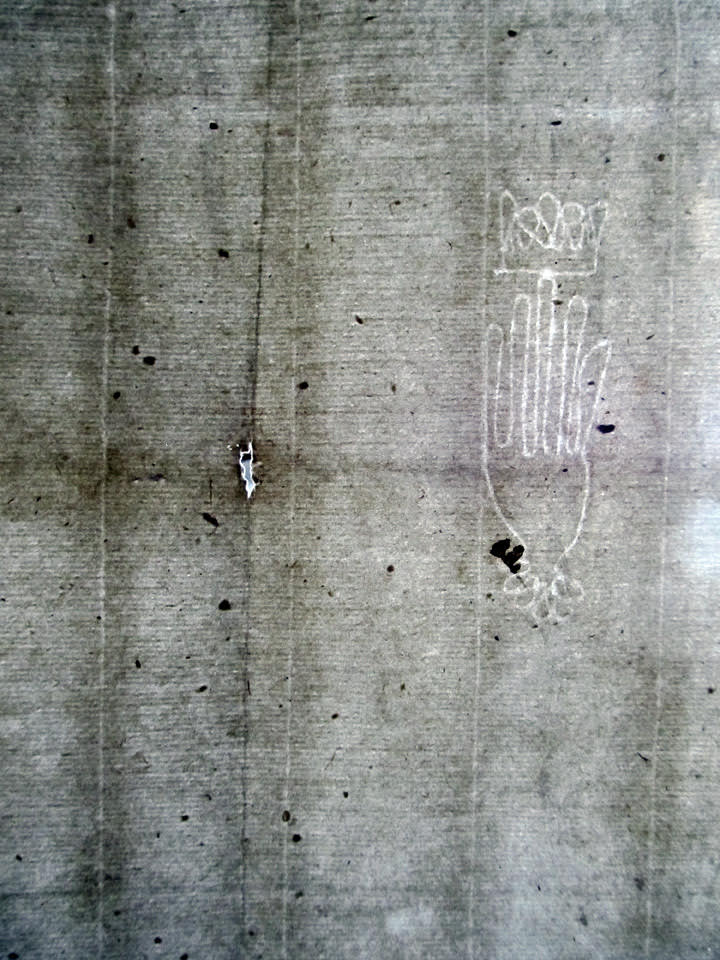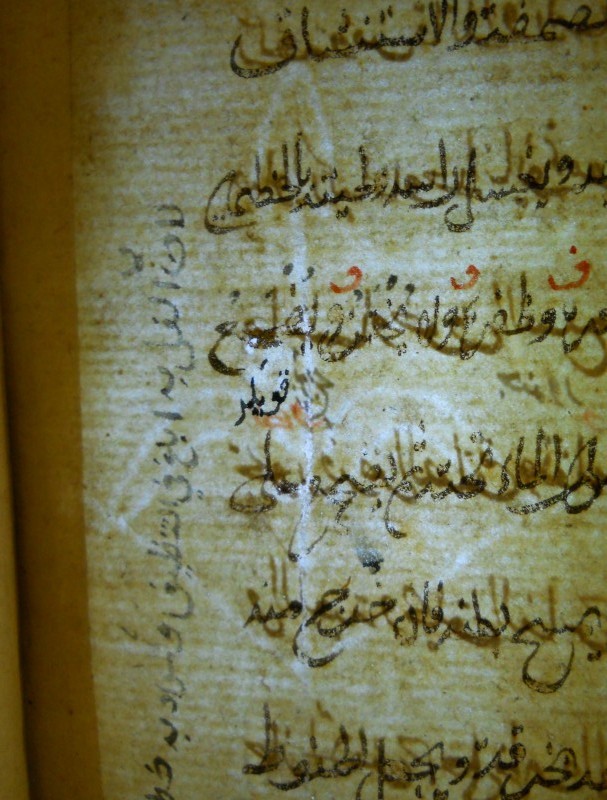Watermarks
&
The History of Paper
With Specimen Samples
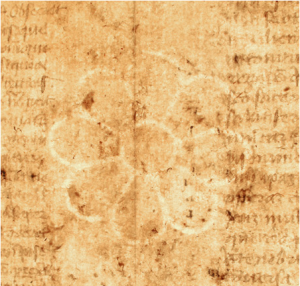
Rosette Watermark in mid-15th-century Latin Book of Saints.
[Posted on 5 July 2020, with updates]
We offer selected Samples or Specimens of watermarks for consideration, as we advance (individually and collectively) with gathering together some “sightings” of watermarks found in diverse locations — in manuscript, print, and other settings. Encountered in the course of research on multiple subjects, these Specimens demonstrate usages which may range widely in terms of geographical locations, purposes, languages, and dates or date-ranges. Some specimens are dated or datable. Some (not necessarily the same as those) are more or less localizable.
Some have appeared on this site in blogposts, galleries, and the like. For example, see our blog and its Contents List.
The variety may reveal, for example, the use of a given watermark in many different locations and at multiple dates in Western and non-Western settings. Identifying watermarks with a known, likely, or surmised place and span of production may also revise conjectural dates assigned to particular cases of use on stylistic grounds of script or decoration. Thus, a watermark of a known or approximately known date-range could establish that the written or printed production of the item must postdate the conjectured assignment. Bref, an awareness of the “sightings” of watermarks in diverse settings can offer a tool for better dating of specific materials.
First, some Reference Points. Then a selection of Samples. or Specimens, grouped by categories of designs, accompanied by descriptions and, where available, pointers to similar or equivalent watermarks.
Followed by a Mystery Bag, or Mystery Corner, with Samples calling for further identification, study, and classification. Plus a few Notes & Observations about Paper, arising along the way when considering particular specimens.
We welcome your input, advice, corrections, suggestions, and information, including more Samples.
Catalogues & Databases of Watermarks
Many resources online are dedicated to watermarks and the history of paper.
Often they are “confined” to specific interests:
- individual collections (or groups of collections, as with Bernstein)
- particular types of materials (such as archives, incunabula, printed books, prints & drawings, etc.)
- individual printer’s and author’s works (as with William Stansby and Benjamin Jonson)
- languages of the materials in which the watermarks appear (such as Greek)
- particular periods in history (such as the Western Middle Ages or the 18th and 19th centuries)
- and/or regions (as with “Holland, England, and France” or “Finnish, Swedish, and Estonian”).
This — often logistically necessary — concentration or specialization, as research on the vast subjects of watermarks advances, is sometimes linked with efforts to establish and co-ordinate standards for description, classification, and presentation. It also may often entail consultation of multiple reference resources and sites when searching for comparanda in aiming to identify or classify individual watermarks as they might be encountered among original materials.
What to do when the gathering of specimens of watermarks “in the wild”, that is, not within the designated spheres of the established initiatives and projects? For example, in private collections? And when those collections or assemblages cross-over between dates and places of usage of watermarked surfaces, different language groups, types of materials, and the like? At least, showing the specific specimens online might contribute to the process of identification and integration of often dispersed information concerning watermarks, whether in the wild or “captivity”.
Thus we offer some Specimens, ‘unattached’ to any established project on Watermarks, as a contribution to the study of the subject across different types of uses, periods, and places. This aim is not intended to re-invent a wheel, because many research resources provide points of reference, gather bodies of material, offer methods or systems of classification, and advance knowledge both in particular fields and in general scope. We seek a vehicle to transport Specimens of Watermarks encountered in various research settings, not dedicated mainly to Watermarks as such, into a new location where they might ‘park’ among other Specimens so as to receive attention in their own right, among peers, relatives, and, it may be, equivalents.
Online Resources
For example:
- International Association of Paper Historians, with
list of Printed Watermark Repertories (some are online)
Links
IPH Registration Standard for all historical and modern papers and paper items, with or without watermarks,
via IPH Norm 2.1.1 (2013) English or English Version 2.1.1 (2013)
- BERNSTEIN: The Memory of Paper and The Memory of Paper
Bernstein Watermark Terms – Multilingual Vocabulary for Watermark Description, for example sorted by English terms (July 2018)
- EVTEK Paper Identification Database (“Finnish, Swedish and Estonian handmade papers are preferred in documentation”)
- FilHisp – Corpus de Filigranas Hispánicas
- Briquet Online: Charles M. Briquet, Les Filigranes (Paris etc., 1907) > now http://briquet-online.at
- Raymond Gaudriault with the assistance of Thérèse Gaudriault, Filigranes et autres caractéristiques des papiers fabriqués en France aux XVIIe et XVIIIe siècles (Paris, 1995), available online in partial digital facsimile
- The Thomas L. Gravell Watermark Archive or Gravell Watermark Archive, with a list of Watermark Descriptors
- Churchill Online: W. A. Churchill, Watermarks in paper in Holland, England, France, etc. in the XVII and XVIII centuries and their interconnection (Amsterdam, 1935)
via Internet Archive or Hathi Trust
- Heawood Online: Edward Heawood, Watermarks, mainly of the 17th and 18th centuries. The Paper Publications Society (Hilversum, 1950)
— available for download in sections via Islamic manuscripts reference library, under the heading Monographs, listed alphabetically by author’s surname
- Likhachev Online: N. P. Likhachev, Palaeographic Significance of Paper Watermarks / Лихачев Н. П., Палеографическое значение бумажных водяных знаков (St. Petersburg, 3 vols., 1899)
via www.icon-art.info,
Thus:- Vol. 1. Исследование и описание филиграней (“Research and Description of Watermark [Filigrane]”)
- Vol. 2. Предметный и хронологический указатели (“Index and Chronological Indexes”), with
- “Subject [or Thematic] Index” (предметный указатель) in alphabetical order by type, starting with агнец со знаменем (‘Lamb with Banner’), followed by аист во весь рост (‘Full-length Stork’), etc.
- “Chronological Index” (хронологический указатель) from 1293 to 1832 CE
- “Table of Contents”(оглавление) with an index of the “Subjects”
Vol. 3. Альбом снимков (“Album of Images”), with drawings of watermarks, but with a gap between plates 68 and 73 (#366 to #401)
- Likhachev in English: Likhachev N. P., Paleograficheskoe znachenie bumazhnykh vodi︠a︡nykh znakov. English = Likhachev’s Watermarks: An English-Language Version, edited by J. S. G. Simmons and Bé van Ginneken-van de Kasteele (Amsterdam, Holland: Paper Publications Society, 2 vols., 1994)
Watermarks in Archives
- Piccard Online: Gerhard Piccard, Die Wasserzeichenkartei Piccard im Hauptstaatsarchiv Stuttgart. Findbuch I–XVII (Stuttgart, 25 vols., 1961–1997)
- Le filigrane degli archivi genovesi (LABO), with an Index of Tipologie di filigrane genovesi
Watermarks in Incunabula
- Watermarks in Incunabula Printed in the Low Countries or Countries (WILC), from the collections of the Koninklijke Bibliotheek / National Library of the Netherlands
Watermark; also see the Introduction, with information about, for example, methods of reproducing watermarks
- Watermarks in Incunabula printed in España (WIES) or WIES. Watermarks in Incunabula printed in España
Watermarks in Prints & Drawings
Watermarks in Greek Manuscripts
- Robert Allison’s Archive of Papers and Watermarks in Greek Manuscripts or Archive of Papers and Watermarks in Greek Manuscripts
Watermarks and Paper used by or for Individual Authors or Artists
- Stansby Online: A Digital Catalogue of Watermarks and Type Ornaments Used by William Stansby in the Printing of The Workes of Benjamin Jonson (London: 1616)
- Joseph Mallord William Turner (1775–1851)
Peter Bower, Turner’s Papers: A Study of the Manufacture, Selection and Use of his Drawing Papers 1787–1820 (1990)
Peter Bower, Turner’s Later Papers: A Study of the Manufacture, Selection and Use of his Drawing Papers 1820–1851 (London and New Castle, Delaware, 1999)
Specific Regions
- Asparoukh Velkov and Stephae Andreev, Filigranes dans les documents ottomans / Vodni znat︠s︡i v Osmanoturskite dokumenti, Volume 1: Tri Luni = Trois croissants, edited by Bozhidar Raĭkov (Sofia, 1983), in Bulgarian with prefatory matter and table of contents also in French
- Alan D. Crown, Samaritan Scribes and Manuscripts (2001)
- Beate Wiesmüller, The Watermarks from the Refaiya Library, translated by Steven Black
- Sophie Lewincamp, Watermarks within the Middle Eastern Manuscript Collection of the Ballieu Library, The Australian Library Journal, 61:2 (2012), 94-104
Printed Sources
Watermark Photography & Analysis
- David L. Gants, Pictures for the Page: Techniques in Watermark Reproduction, Enhancement and Analysis. Paper delivered at the Annual meeting of the Bibliographical Society of the University of Virginia (23 April 1994)
- A. Alexopolou and A. Kaminari, “The Evolution of Imaging Techniques in the Study of Manuscripts”, Manuscript Cultures, 7 (2014), 58–68.
- David Sorenson, Photographing Watermarks for Beginners (2021)
Etc. Please let us know about additions to the list.
Some Observations
Like many of those ventures, we group the watermarks on display according to their designs or motifs, in classes or categories, with sub-groups or sub-categories. (See below.)
Our first aim is to gather the specimens from research work on various projects. Examples include some materials which have appeared in our blog, in our galleries, and elsewhere on this website. Such reports focus usually on multiple features and aspects of the materials. Here we focus upon the watermarks themselves.
As the specimens continue to gather, we can prepare for a method or system to present the corpus in database form. A choice among several different standards of description of watermarks and paper might form part of that later stage, as resources gather to advise and underpin such presentation.
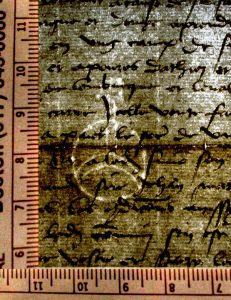
Private Collection, Single-Sheet Document for Land Purchases in Athis, France, dated 1493-1509: Watermark of a Cross-Bearing Orb.
For now, we assemble the images and the metadata for specimens in order better to arrive at that stage. This webpage offers a gathering place for scholars, collectors, and others, who may wish to see, and to show, watermarks of interest and curiousity. Showing specimens while we continue to gather the materials, and to prepare appropriate images (for example, with scales in view), might encourage additions of specimens to include, corrections and refinements for the metadata of individual specimens (dating, localization, etc.), and further comparanda for them.
The numbering system at present may well undergo revision, especially as more specimens, and more types/classes/categories of watermarks join the groupings. We provide a unique Identifier of some kind, whether pressmark or other, such as title or descriptor. For materials without assigned pressmarks (or the like), as may be the case in some collections, a brief description serves as a holding pattern, while information might gather in order to find an appropriate title, collection number, or similar.
Occasionally, en passant, in the course of considering individual or related cases, we offer observations about particular features, the formation of watermarks, and other effects — as with A Note on “Watermark-Wire” and A Note on Job-Lots. We signal those more general comments by titles in red. Cross-references to those comments gather in the concluding section called Notes on the History of Paper.
At the end, following the displayed Samples arrayed in their Groups and Subgroups, we offer a Mystery Corner with some specimens that exhibit challenges for classification and identification. We invite contributions to the quest and suggestions for more.
What’s In a Name: Motifs, Designs, Types, Classes, Subclasses, Etc.
In Bricard, the List des motifs principaux groups multiple categories alphabetically; within each one there are gathered multiple variations.
Piccard Online sorts the types of Motive into these broad groups (with many tiers of subdivisions):
Figuren, anthropomorphe
Fabelwesen
Berge/Himmelskörper
Symbole/Herrschaftszeichen
Wappen
Buchstaben/Ziffern
Fauna
Flora
Realien
Geometrische Figuren
Marken
unbestimmte Zeichen
Approaches to co-ordination of terms yield guides from varied perspectives and purposes. For example:
-
-
- the “Watermark Descriptors” in some sites cited above
- the Bernstein Systematics, with three level systematics of watermark motifs in English, French, German, Italian, Russian and Spanish
- and the IPH Standard set out by the International Association of Paper Historians.
-
The IPH Standard provides an alpha-numeric key to watermark classes and subclasses. Assigned capital letters in alphabetic sequence (according to the Latin alphabet), its main classes are:
A. Human figures; men; parts of the human body
B. Women
C. Mammals
D. Birds
E. Fish, reptiles, insects, molluscs
F. Mythical figures
G. Plants (general); flowers; grass
H. Trees; shrubs; creepers
J. Sky, earth, water
K. Buildings, parts of buildings
L. Transport, vehicles
M. Defence and arms
N. Tools, equipment, clothing
O. Musical instruments
P. Containers
Q. Miscellaneous objects
R. Insignia of rank, sceptre, mace, jewellery
S. Religious or magic symbols and signs
T. Heraldry, coats of arms, mason’s marks, trademarks
U. Geometric figures
V. Numbers, numerals
W. Individual letters
X. Monograms, abbreviations with letters
Y. Names (in full)
Z. Unclassifiable watermarks
Not always do the subclasses which subdivide these IPH main groups suit a particular body of material, as remarked by WILC:
Only the letters of IPH’s main classes have been given. Its subclasses are inadequate for the differentiation of WILC’s subgroups . . .
Similarly for the Gravell Watermark Archive’s Watermark Descriptors:
While useful, this index does not always use terms that are congruent with, e.g., Briquet’s classification, and occasionally employs terms that are, today, offensive to many, e.g., “Negro, head of.” We have attempted to use the IPH Key when possible, at least to associate their main class with our primary descriptors [italics added].
For now, we take note of these offerings, and present the specimens which come to hand with reference principally to Briquet’s system of classification — for some of us, a first port of call for many years now when considering watermarked materials — and frequently to Piccard’s. Call it a starting point. Our verbal descriptions offer salient distinguishing features of the individual marks which may allow readily for transposition into a different numeric, alpha-numeric, or other form of classification.
As we assemble the specimens and our notes about them, while updating the information and (sometimes) providing new photographs, it seems viable to present the Briquet/Piccard comparanda as it stands to hand. Citations to others will emerge as they arise. We continue to explore and to revise, and we welcome suggestions and advice.
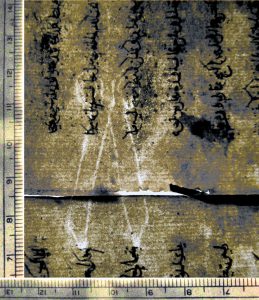
Private Collection, Turkish Binding Fragment, Scissors Watermark.
Our Approach to Motifs, Pro Tem
Without aiming to set out a new system of classification, while seeking to gather specimens which may fall outside the spheres of most projects (say by virtue of the location or ownership of the specimens), we show specimens in broadly defined groups — such as “Floral”, “Fruits”, “Animals”, etc. — so that additions to the specimens, as they arise, might fit within those general groups.
This approach can assemble specimens by such groupings rather than by their date of “admission” into our presentation here. In time, they might fit within a database arrangement.
For now, we begin to assemble specimens which have come to our attention in the course of individual or collective work over some years. We welcome advice, additions, and improvements.
Samples or Specimens for Consideration
We offer some samples which we have encountered in the course of cataloguing or researching manuscript or printed materials of various kinds. In presenting them, we include elements or fields of information. Mostly, they belong to private collections. We thank the owners of the materials for permission to reproduce them here.
Ideally, our presentation might include all the following considerations (and more if indicated), as the work to present the specimens advances.
Fields of Reference for a Database
1. Identifier: [E. g. Location, Collection, Shelfmark, Folio Number]
2. Watermark
Type (Motif)
Scale (in centimeters or inches)
Match or Closest Match (Briquet, Piccard, and/or other standard)
Image(s), ideally with measurement scale in view: Photograph / Drawing / Both
3. Paper
Laid Lines: Number per cm. or per in.
Chain Lines: Spaced in cm. or per in.
Chain-line grouping (for non-Western): single, double, triple, quadruple, three/two, irregular
Pulp-drift: Present/Absent
Rib-shadows (i. e., pulp settling in low points between reinforcing “ribs” in the frame): Present/Absent
Chain Wire Stitching: Present/Absent
Attachment of Watermark to Chain-line or (Water)mark line: Present/Absent
[Etc.]
4. Text (if any):
Manuscript / Print / Both
Type of Text: E. g., Document / Chronicle / Etc.
Name of Author, Text, Printer, etc. (if known)
Standard reference for the work, if available: E. g., ISTC Number of the Edition / Etc.
5. Script Sample (if applicable and available):
[Image]
6. Language(s):
7. Date:
Dated [How] / Datable [How] / Probable Date-Range
8. Origin:
Known / Knowable / Conjectured [How]
9. Others?
See also the section below on Notes on the History of Paper
Specimens
We offer Specimens. Where possible, we show photographs of them with a scale in the frame at the time of the photography itself. Not all the images available have such a scale in the frame, not least when there is no opportunity to photograph anew, as when the original has disappeared, when it has become inaccessible, or when it has altered somehow.
In preparation is a “neophyte’s guide” to photographing watermarks. It would take into account photography under varied conditions, with various equipment, lighting, etc.
Note that the scale in these images is marked in centimeters.
Motif Group I: Flora
Subgroup I.1. Flowers
Specimen I.1.1. 7-Petaled Flower with a Circular Center
Private Collection, “Rainerus 1474 Fragments”
Set of 3 printed leaves from a dismantled copy of Rainerius de Pisis, Pantheologia: sive Summa universae theologiae (Augsburg: Günther Zainer, 1474) = ISTC ir00007000 .
An online facsimile of a full copy:
Electronic facsimile : Bayerische Staatsbibliothek, München
1 leaf has a watermark.
Watermark
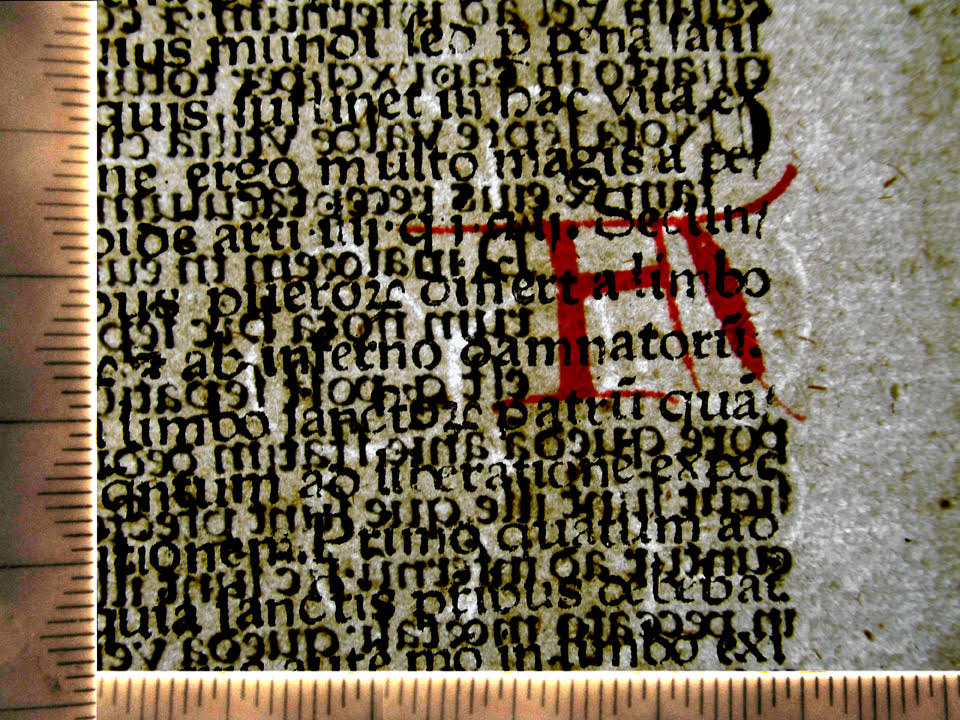
Rainerus de Pisi, Panthelogia (Augsburg, 1474). watermark.
Relatives or Equivalent
Probably Briquet 6557 “Milano 1462” or 6560 “Vercelli 1473”
(Fleur | à sept pétales)
For example, Briquet 6557:
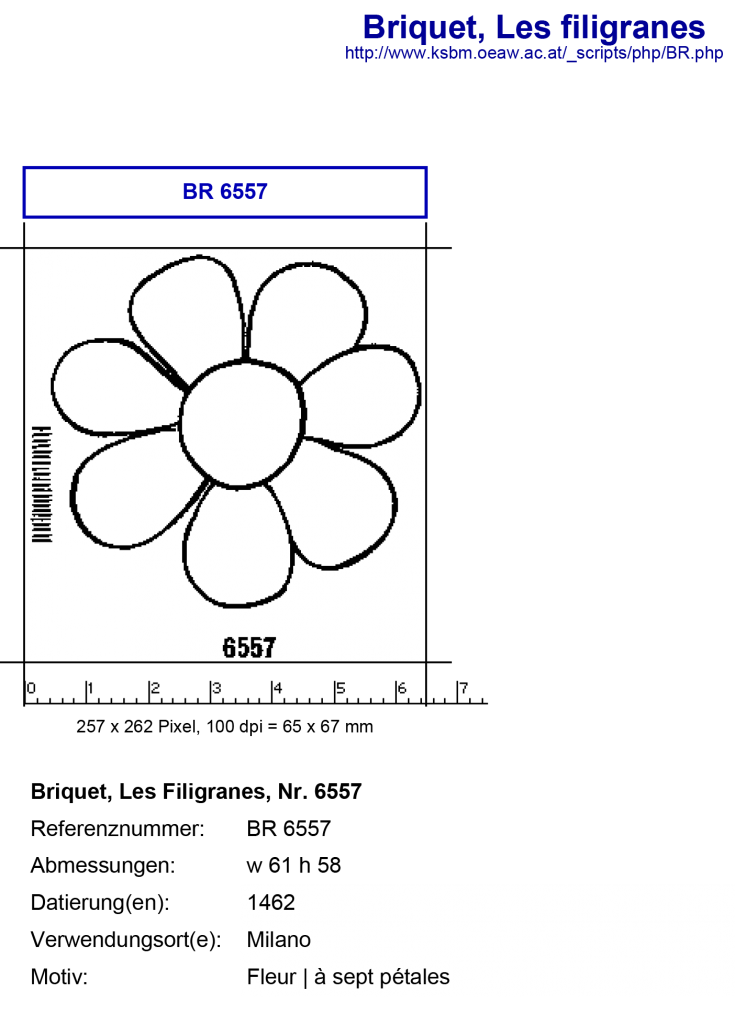
Briquet 6557 Flower with 7 Petals.
*****
Specimen I.1.2. Rosette with 8 Petals around a Circular Center
Identifier: Private Collection, Bifolium from a mid 15th-century book of saints’ lives in Latin, probably from Italy — to judge by the script, watermark, and interest in Italian saints.
Script Sample
Last page (page ‘4’) of the bifolium, with the end of the Vita of Saint Zeno of Verona and the beginning of the Vita of Saint Syrus, with its opening title in red.
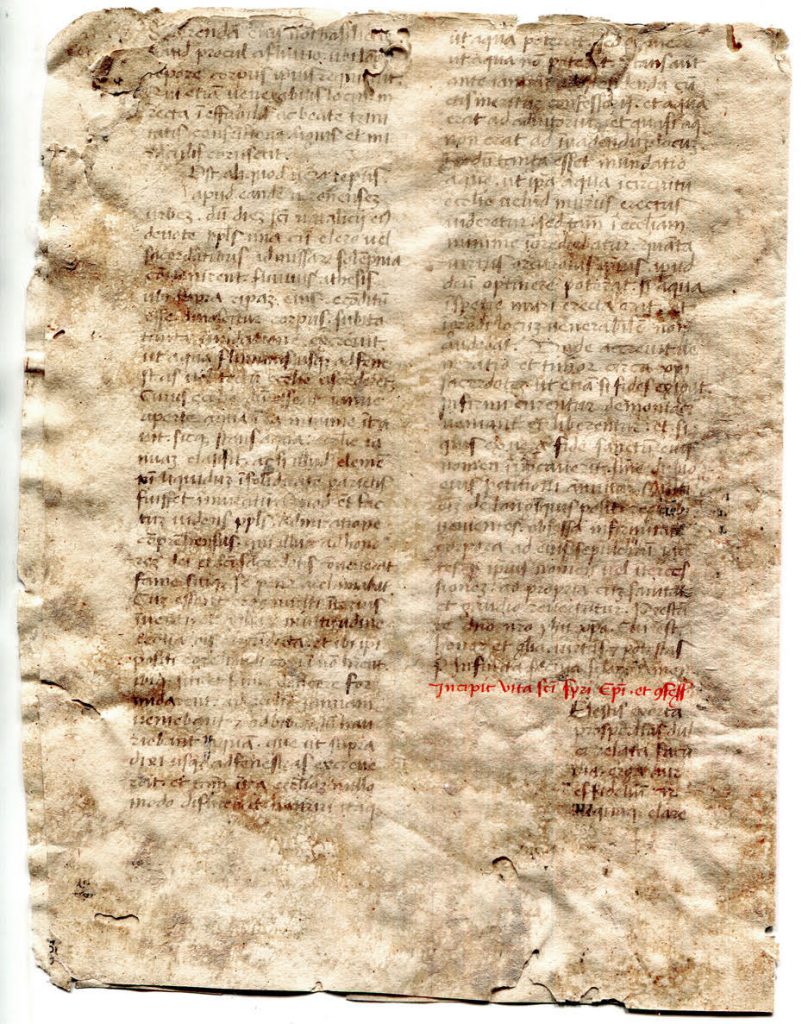
Private Collection, Page 4 of Bifolium from a mid-15th-century Latin copy of Saints Lives.
Watermark
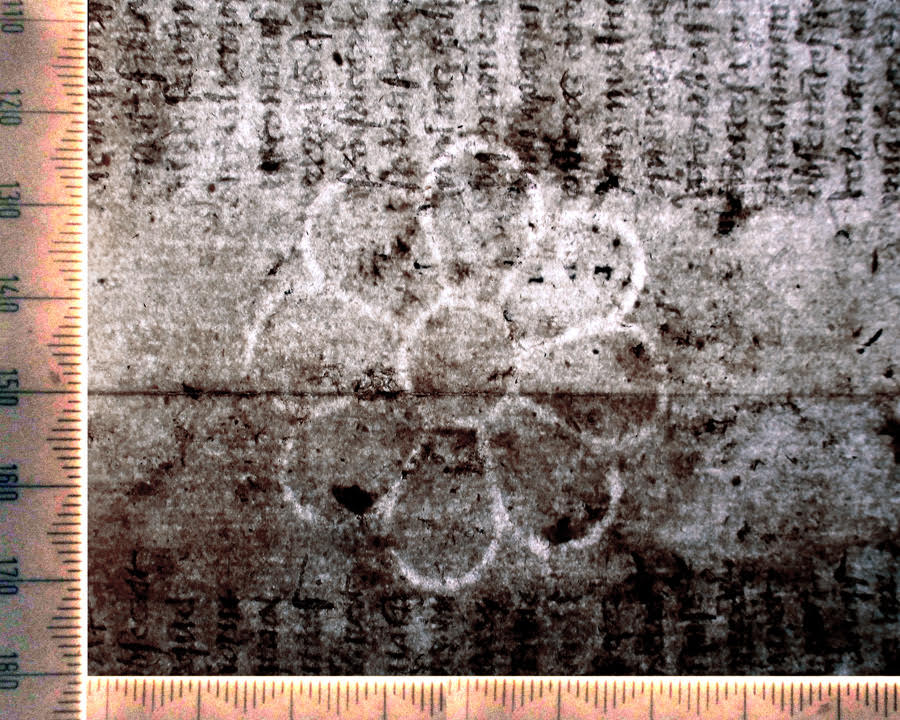
Rosette Watermark in mid-15th-century Latin Book of Saints.
Another view.
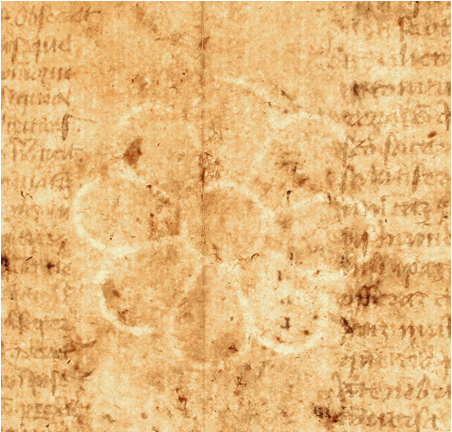
Relatives
Briquet 6588, 6591, 6592, 6596, 6597, 6601, and 6602
(Fleur | à huit pétales)
For example, Briquet 6597 “Chiavenna 1465”

Briquet 6597 Flower with 8 Petals, via Briquet Online.
Briquet 6601 “Lecco 1480”
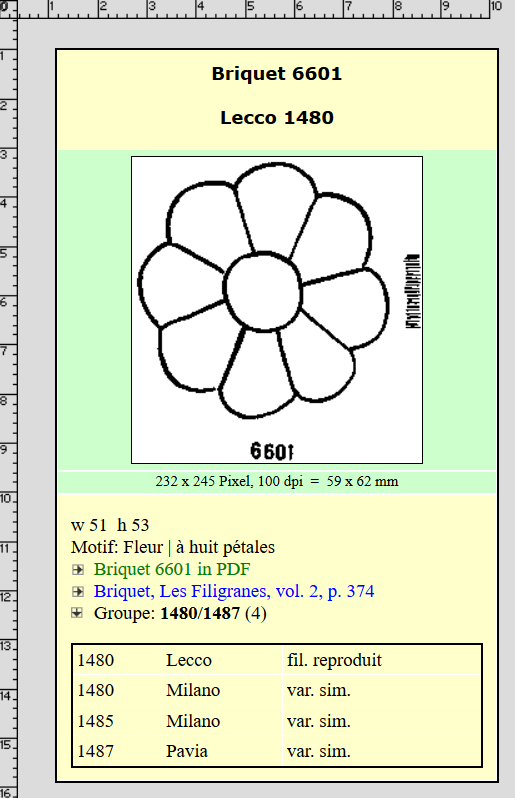
Briquet 6601 Flower with 8 Petals, via Briquet Online.
*****
Subgroup I.2. Fleur-de-lys
Specimen I.2.1. Fleur-de-lys on Its Own with Trifurcated Stem and Curled Side-Lobes
Identifier. Private Collection, Undated Turkish Manuscript of 5 leaves with 2 Watermarks (Fleur-de-Lys and Char, “Chariot or Cart”)
Type of Text: Hadith Commentary in single columns
Script Sample
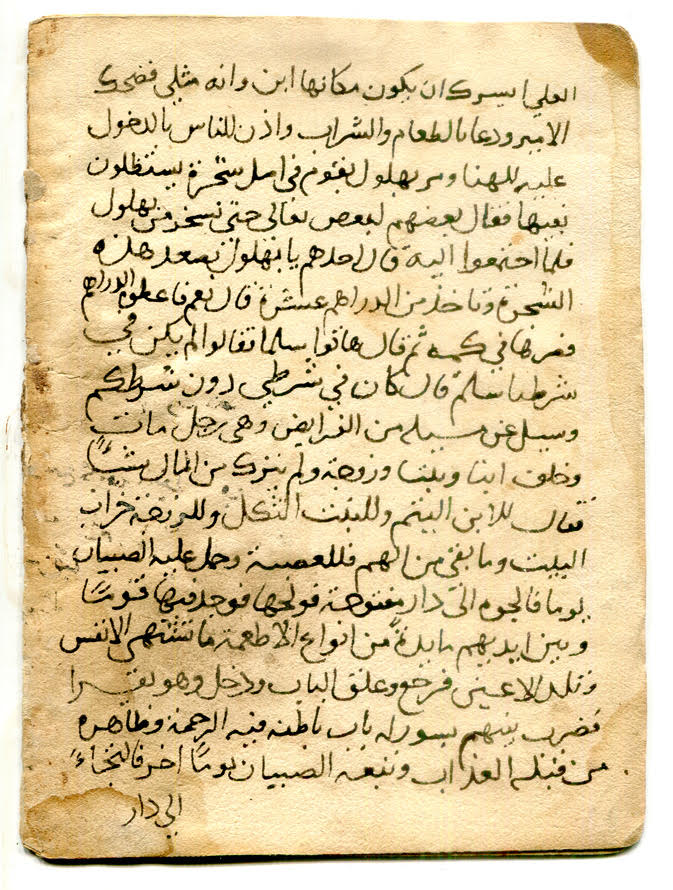
Page from a 5-leaf Hadith Commentary.
Watermark
The mark has a lanceolate upper lobe, trifurcated stem, and tapered lobes at the sides which curve downward to outward-curled tips.
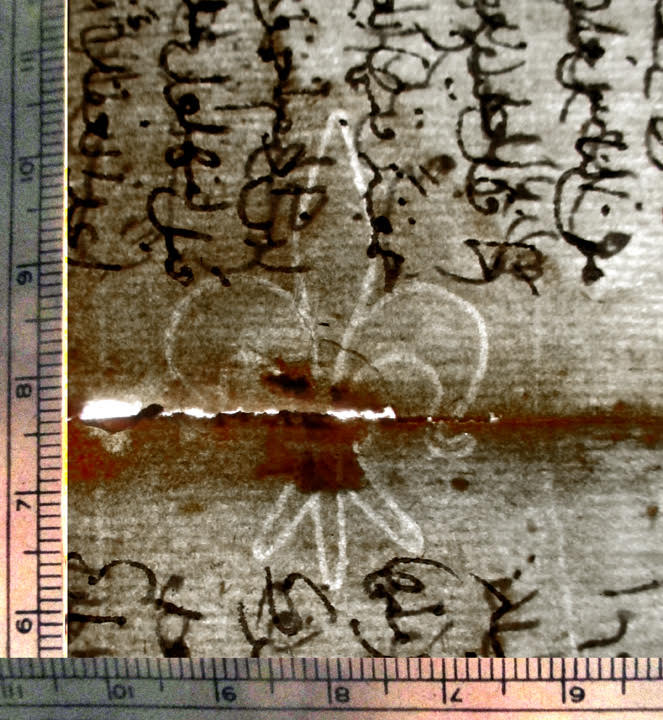
Fleur Watermark Turkish MS close to Briquet 6915.
Relatives
Closest in Briquet is 6914 “Fribourg 1456”.
Fleur de lis | simple | Isolée
[Also see below, Specimen IV.4.1.1: Char Watermark in the same manuscript.]
*****
Motif Group II. Fruit
Subgroup II.1. Individual Fruits or Clusters
Specimen II.1.1. Cluster of Grapes on Thick Stem with Looped Top
Fragment of 3 leaves of Selbold Cartulary Fragments. See also Latin Cartulary from Selbold (Hessen), that is, Kloster Selbold.
Comprising 1 single leaf + 1 bifolium from different parts of the former volume, the paper leaves have 1 watermark on their bifolium.
Manuscript: Single columns of 38 lines
Language: Latin
Text: Cartulary Fragment of a late medieval copy in book form of the texts of 8 documents issued by ecclesiastical and secular rulers in the 12th to 14th centuries recording the privileges and rights of the monastery or abbey at Selbold in Hessen, Germany.
Date: Late 14th- or early 15th-century to judge by the script.
Place of Origin: Presumably Kloster Selbold or its region.
Script Sample
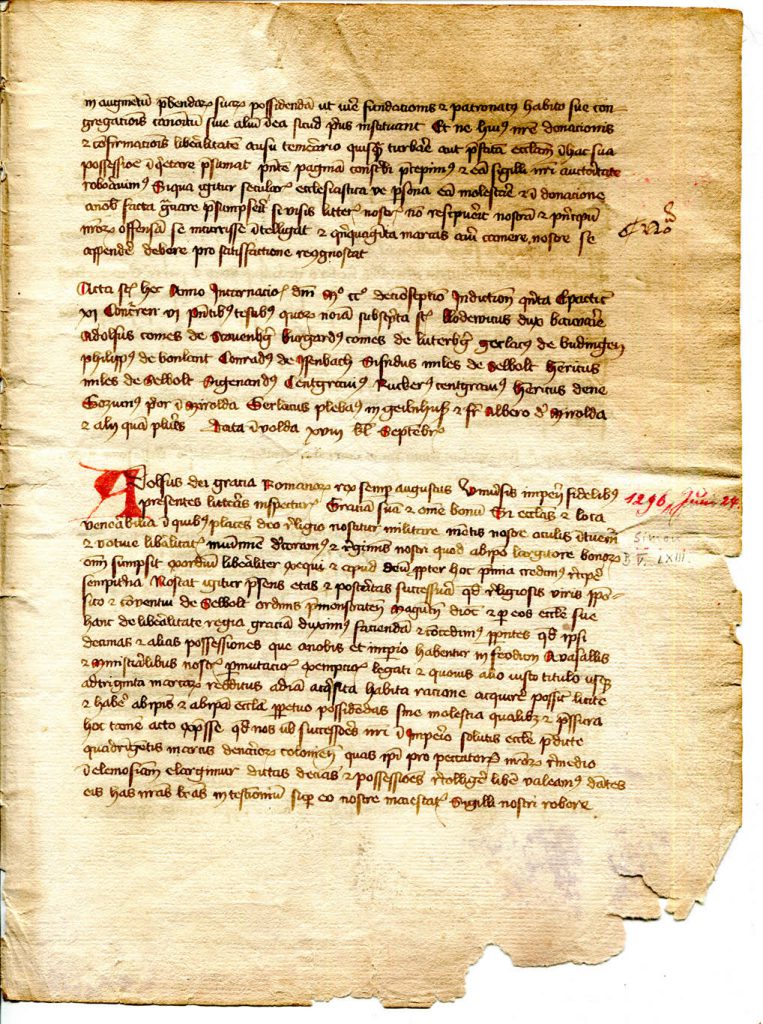
Private Collection, Selbold Cartulary Fragment, Folio 3 recto.
Watermark
Cluster of Grapes with Large Stem, which subdivides the clusters of fruit. The stem undulates along its length and rises to a backward-turned loop crossing “behind” the stem from right to left.
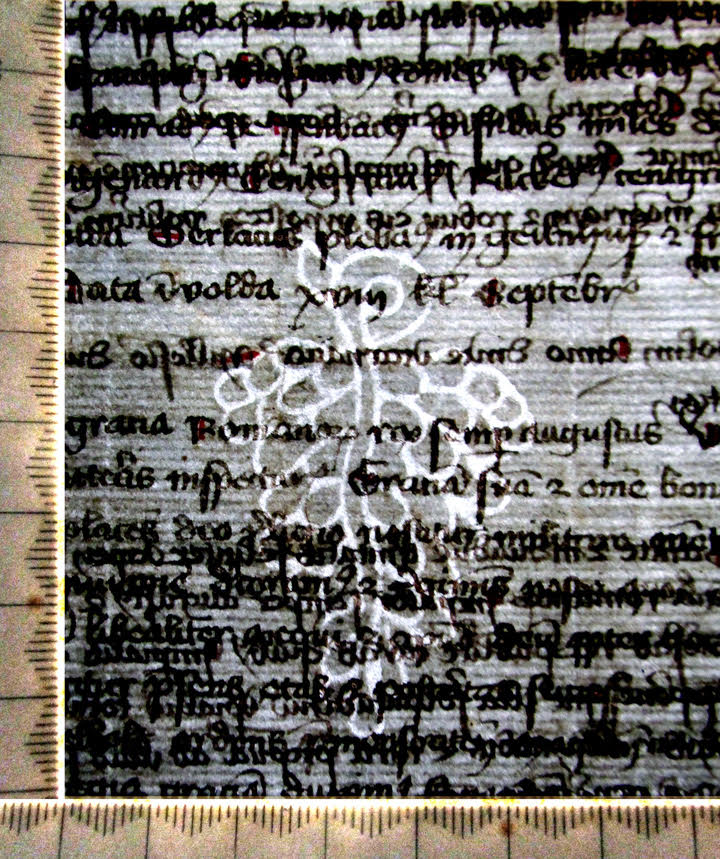
Grapes Watermark in a Selbold Cartulary Fragment, with Back-Lighting and Scale.
Another view.
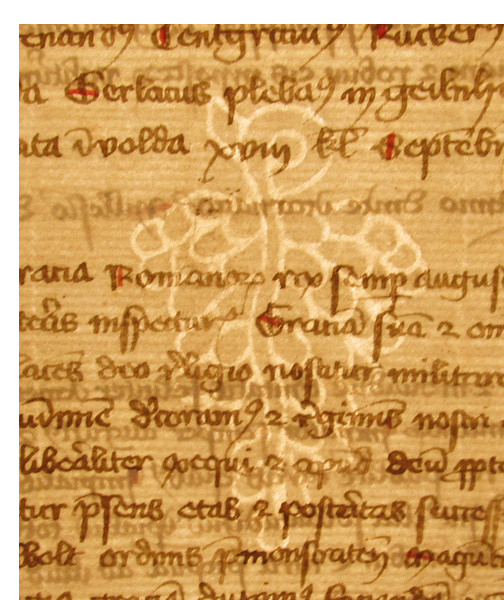
Grapes Watermark.
Relatives
Related specimens include
Briquet 12991 “Solothurn 1420”
and
13003 “München 1478”
Raisin | à grosse tige
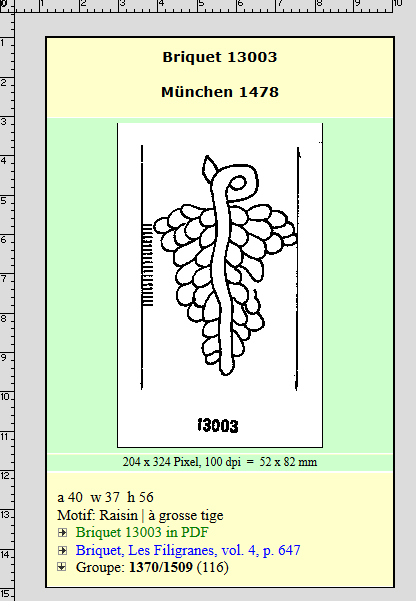
Briquet 13003 Grape Cluster with Thick Stem, via Briquet Online.
Piccard Motif: Ranke . . . = Flora – Frucht – Traube – ohne Beizeichen – Stiel zweikonturig – mit Ranke – Ranke hinten geführt
*****
Motif Group III: Stars, Suns & Heavenly Bodies
Subgroup III.1: Star or Sun
Specimen III.1.1. Star or Sun with 7 Pointed Rays
Identifier. Private Collection, undated Latin manuscript containing an Italian lawyer’s miscellany, from Italy (Ancona?), perhaps late 15th century.
Its texts include a form of oath for Jews and a method of verifying confessions obtained under torture. One of its essays mentions Pope Calixtus “of blessed memory”. Of the 3 Popes named Calixtus, with reigns respectively in the 3rd century CE, the 12th century, and from 1455 to 1458, the one mentioned here must be Calixtus III, providing a dating terminus post quem of the date of his death on 6 August 1458 at least for that text.
Script Sample
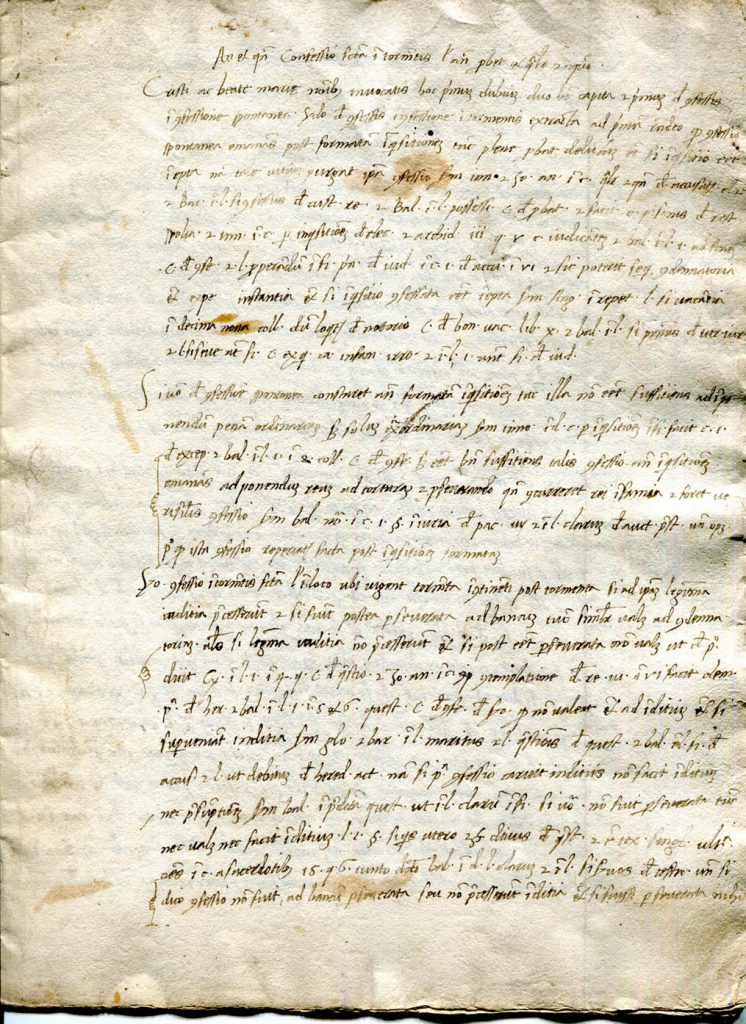
Private Collection, Italian Lawyer’s Miscellany on Paper.
Watermark
The mark has long and unevenly spaced rays of different widths. The straight, finger-like rays taper with straight sides to somewhat rounded tips.

Private Collection, Watermark of 7-rayed star, late 15th century. “Inverted”.
Relatives
Compare the 2 marks in Briquet: 6051 “1396/1399” and 6052 “1589”
Etoile | à sept rayons
According to the collector, there is “No reasonable match in Briquet. One is much too early, the other much too late, and neither very close in appearance.”
Compare Piccard:
Free-standing Sun with 7 Rays
Berge/Himmelskörper – Sonne – frei, ohne Beizeichen – ohne Inhalt – sieben Strahlen
(However, these have undulating, rather than straight, rays.)
Free-standing Star with 7 Rays
Berge/Himmelskörper – Stern – siebenstrahlig – frei, ohne Beizeichen
(These have straight rays, but mostly from a rounded center.)
Closest in form, without a marked center, seems to be DE8085-PO-41664 “1546, Frankreich”, but with short rays.
*****
Specimen III.1.2. 6-Rayed Star in Circle
Identifier: Private Collection, Italian astrology manuscript in Latin.
The text is Pseudo-Ptolemy’s Centiloquium (“Hundred Sayings or Aphorisms”) about astrology and astrological principles, in the Latin translation from Arabic by Plato of Tivoli in Barcelona in 1136 (‘anno Arabum 530’). On this text (“Work B.1.2”), see the entry in Ptolemaeus Arabus et Latinus, with bibliographical references and lists of editions, extant manuscripts, and Latin commentaries. An online transcription, with annotations, represents widely Henry Coley’s 17th-century English translation: Centiloquium Ptolomei, Or Ptolemy’s Centiloquium Englished.
Otherwise complete, this copy appears to be missing the first and last leaves. The several differences in the text are most likely due to being a student’s jotted-down copy. It deserves to be included among the extant list.
The paper is watermarked. The latest of the three possible candidates for the mark among Briquet’s specimens is from Bologna, dated 1481.
Script Sample
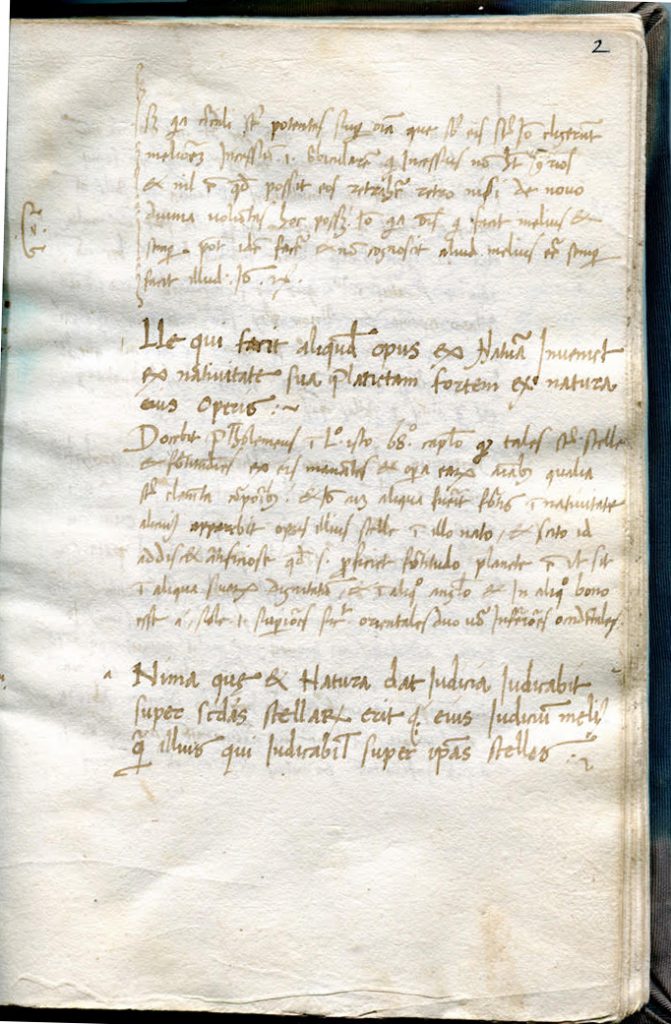
Private Collection, Italian Astrology Text, Folio 2r.
Watermark
The watermark presents a 6-pointed star of equal rays with pointed tips which touch the unevenly drawn circle enclosing it. From the top of the circle rises an extended staff topped apparently by a cross.
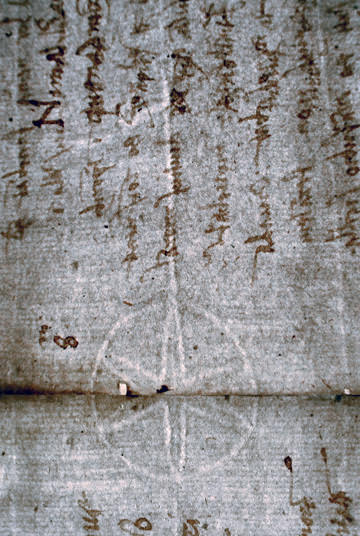
Private Collection, Italian Astrology Text, Watermark.
Comparanda or Equivalents
1. Briquet 6078 “Bologna 1473”
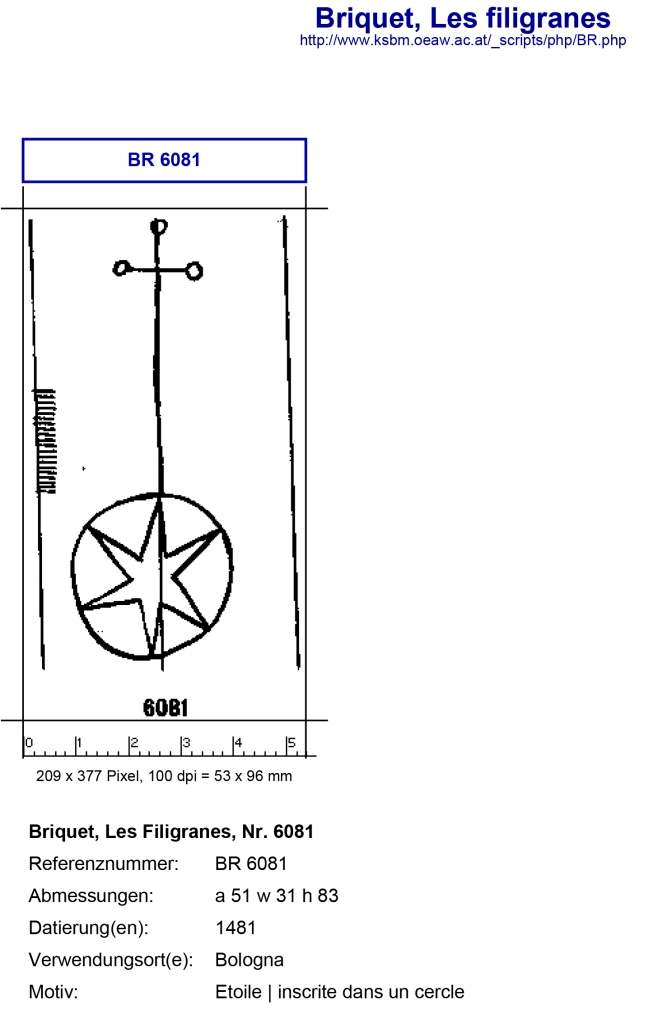
Briquet 6078: Star in Circle.
2. Briquet 6081 “Bologna 1481”

Briquet 6078: Star in Circle.
*****
[See also Specimen V.3.3.1. Crescent Surmounted by a Crown of 5 Rays and Suspended from a Cross]
[See also Specimen VII.1.1.1. Glove with Star]
*****
Motif Group IV. Realia (Tools, Weapons, Etc.)
Subgroup IV.1. Tools
Sub-Subgroup IV.1.1. Scissors (see Briquet, Ciseaux)
Specimen VI.1.1.1. Scissors with Long Blades and Short, Curled Handles
Identifier. Private Collection, Turkish Binding Fragment. The detached bifolium was probably reused in a binding board, because its wormholes do not line up. The text comprises a mixture of Arabic and probably Turkish (with some non-Arabic letters such as p and ch).
Language: Arabic etc.
Script Sample
In red, fazi (“section”).
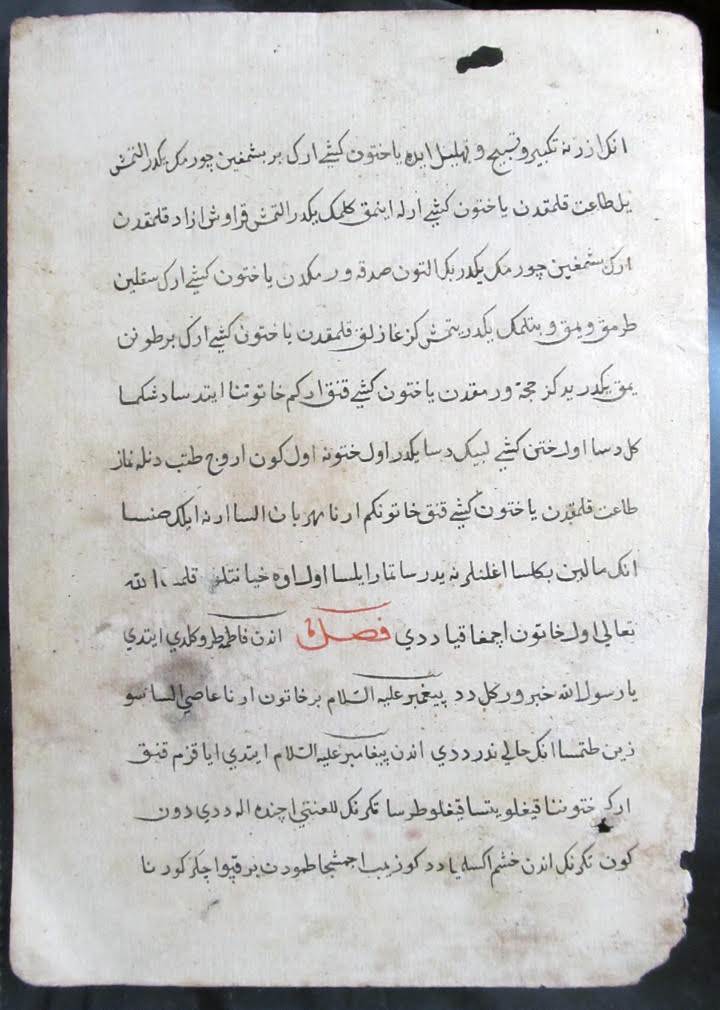
Private Collection, Turkish Bifolium with scissors watermark.
Watermark
The narrow, curled handles appear to be open-ended. With more-or-less parallel contours, but somewhat different widths, the long, straight blades taper to pointed tips.
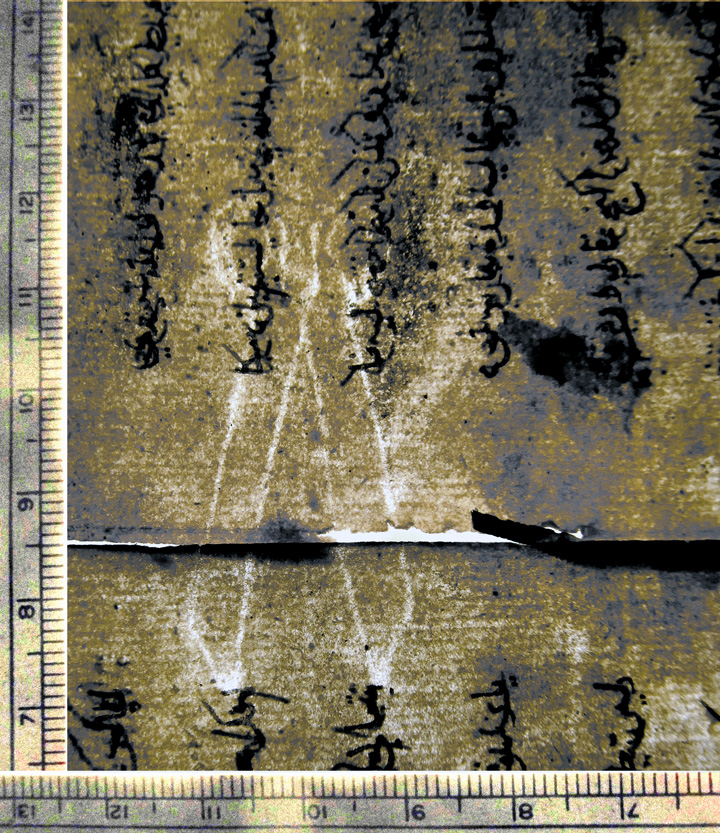
Private Collection, Turkish Binding Fragment, Scissors Watermark.
Comparanda
Briquet 3670 1427/1435 “Treviso 1458”
or probably (having the longer blades and more closely curled finger holes)
Briquet 3669 1457/1460 “Genova 1457/58”
Ciseaux
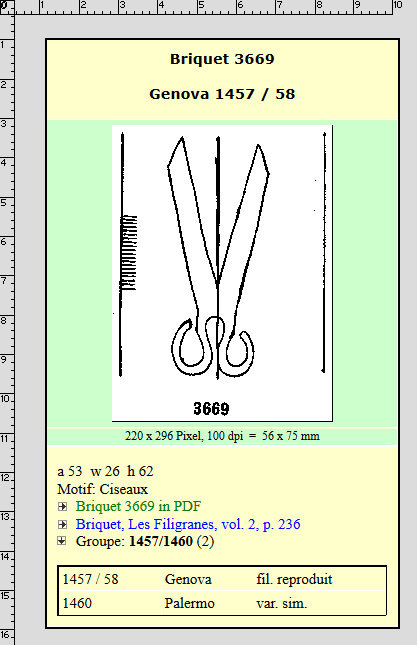
Briquet 3669 Ciseaux, via Briquet Online.
*****
Specimen IV.1.2.2. Scissors with Curled Letter or Mark (G?)
Identifier. Manluq Manuscript of a Treatise on Islamic Law, made up of different types of paper. Mostly the sheets are Mamluq-style paper with lines barely visible, with a few sheets of Western-style watermarked paper (“Watermark 1”), plus a newer section with different watermarks (“Watermarks 2 and 3”).
The manuscript is undated. It has a reader’s note at the end with the date AH 860 / CE 1456.
The 3 Watermarks:
- Specimen IV.1.2.2. Scissors and Curled Letter or Mark (G?) on a few sheets in the main section
- Specimen V.3.3.1. Crescent Surmounted by a Crown of 5 Rays and Suspended from a Cross
- Specimen VII.1.1.2. Glove with Tapered Cuff Ending in Rippled Edge
Script Sample
A specimen opening contrasts the Mamluq-style paper and the Western-style watermarked paper, and the different styles of writing upon them.
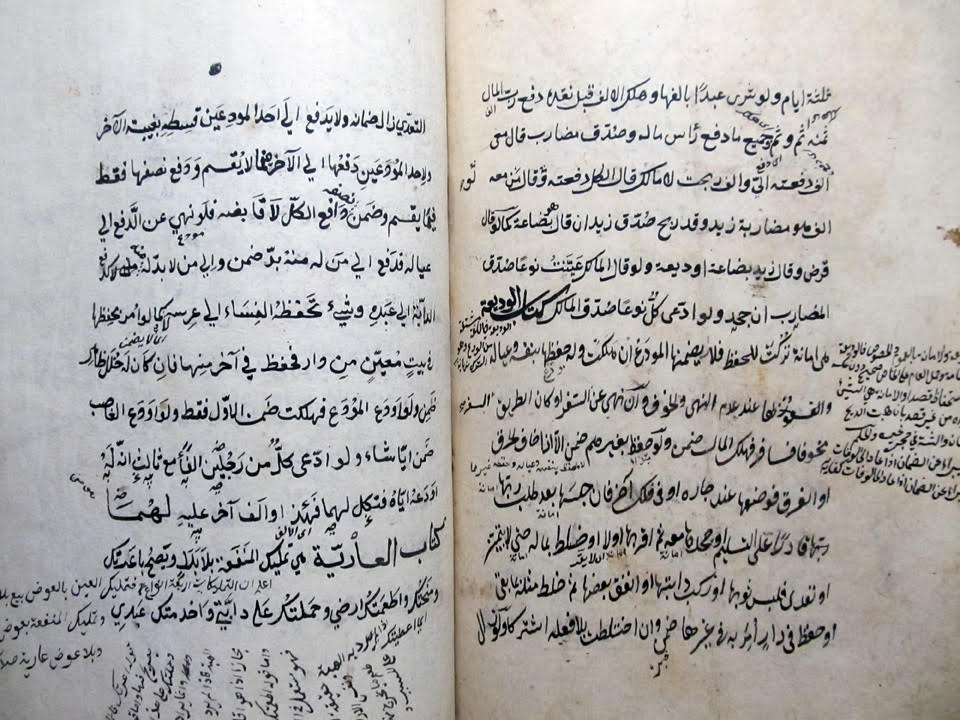
Private Collection, Treatise on Islamic Law, with both Mamluq-style paper and 2 sections with watermarks: Specimen opening with western and Mamluq style paper.
Colophon
The manuscript is undated.
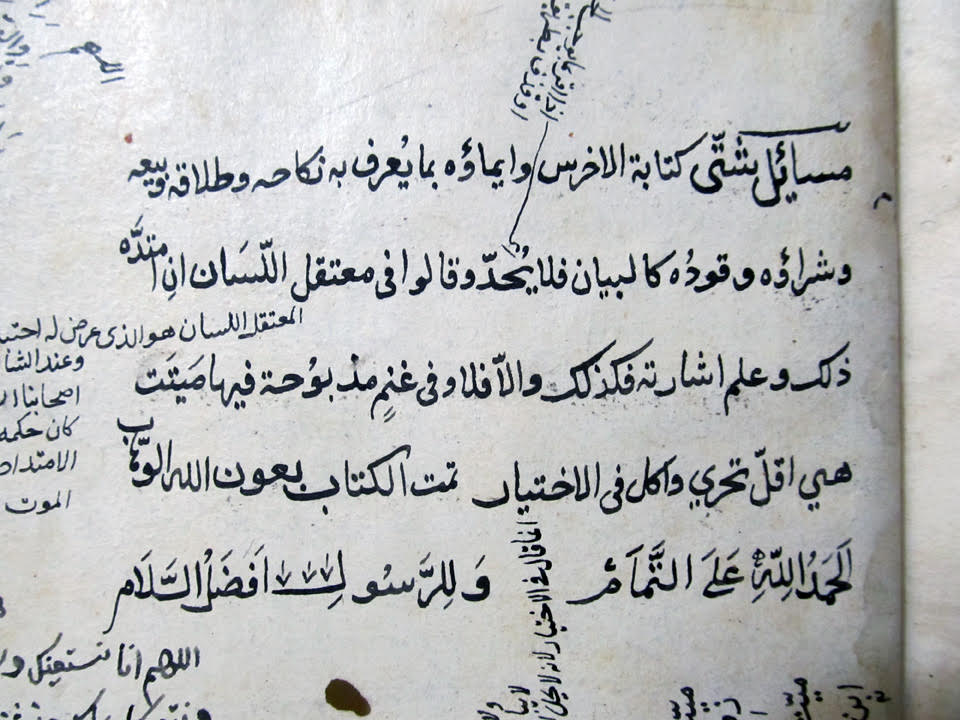
Private Collection, Mamluq Manuscript of Treatise on Islamic Law, Colophon (undated).
Reader’s Note with Date
At the end of the manuscript, a reader’s note carries the date AH 860 / CE 1456. This is probably not the earliest reader’s note in the volume.
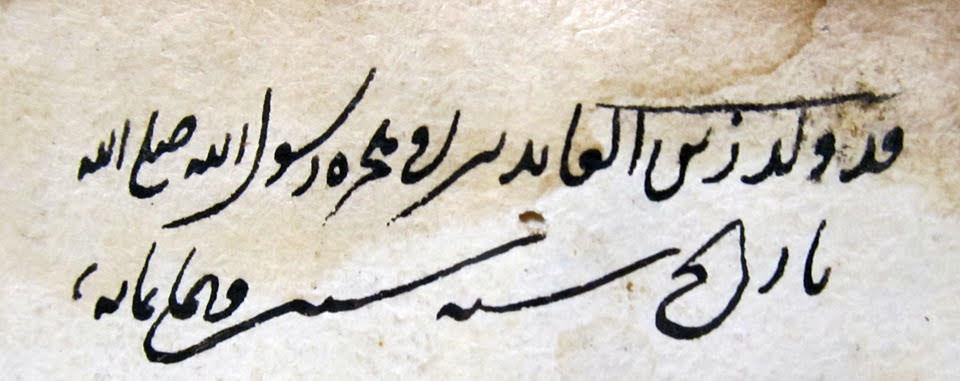
Private Collection, Mamluq Manuscript of Treatise on Islamic Law, Dated Reader’s Note.
Mamluq-Style Paper
The lines are barely visible.
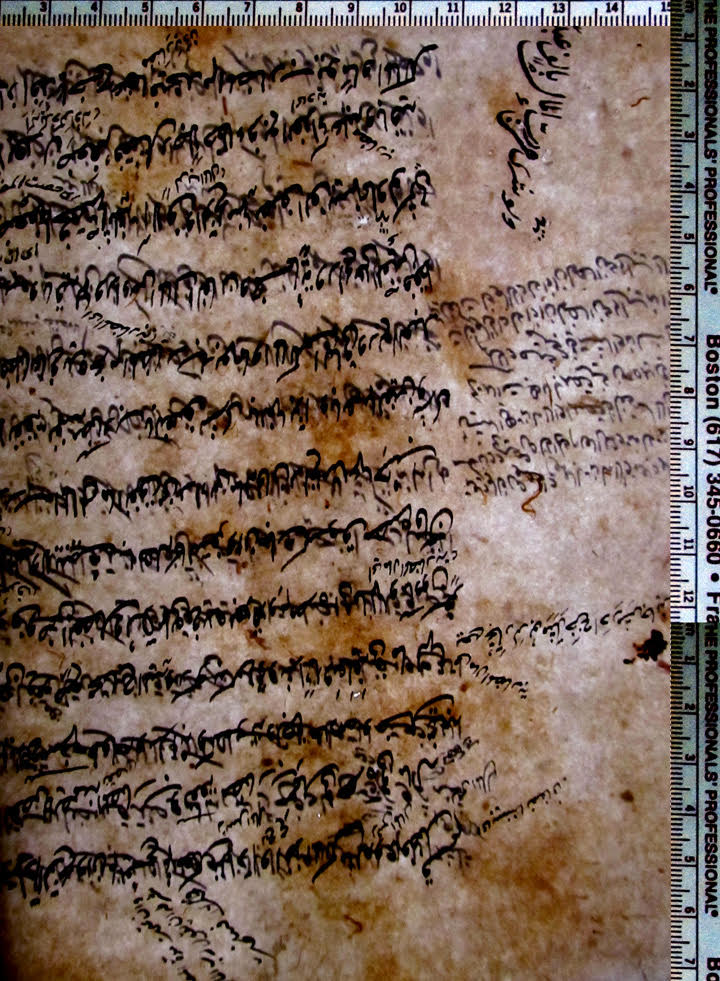
Private Collection, Mamluq Treatise on Islamic Law, with both Mamluq-style paper and 2 sections with watermarks: Specimen of Mamluq-style paper.
Watermark 1: Scissors and Letter or Mark
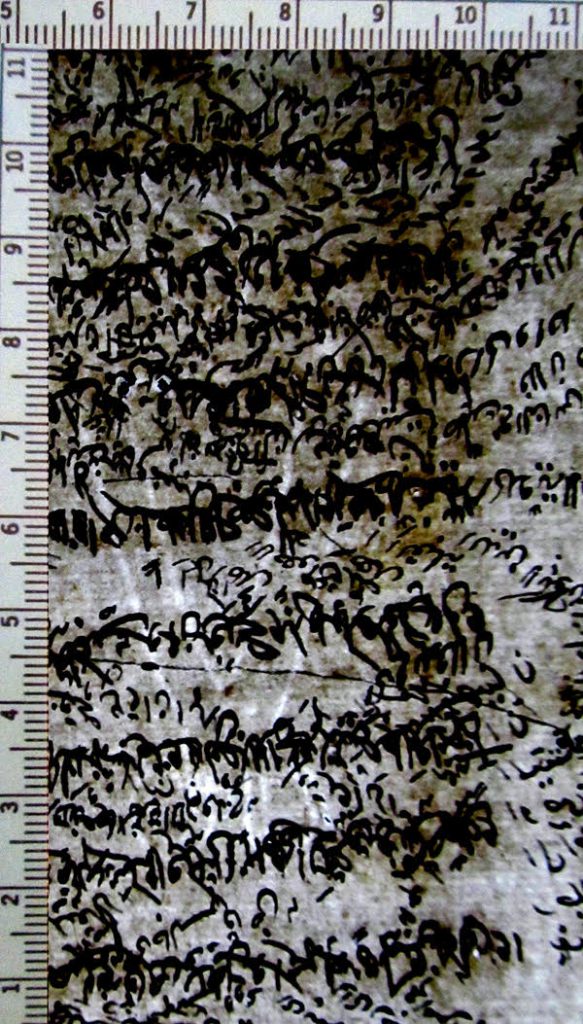
Private Collection, Treatise on Islamic Law, Section of a few sheets with watermark of Scissors with G.
Comparanda
Briquet 3694 (etc.) “Genoa 1433/1434”. 1430s and later.
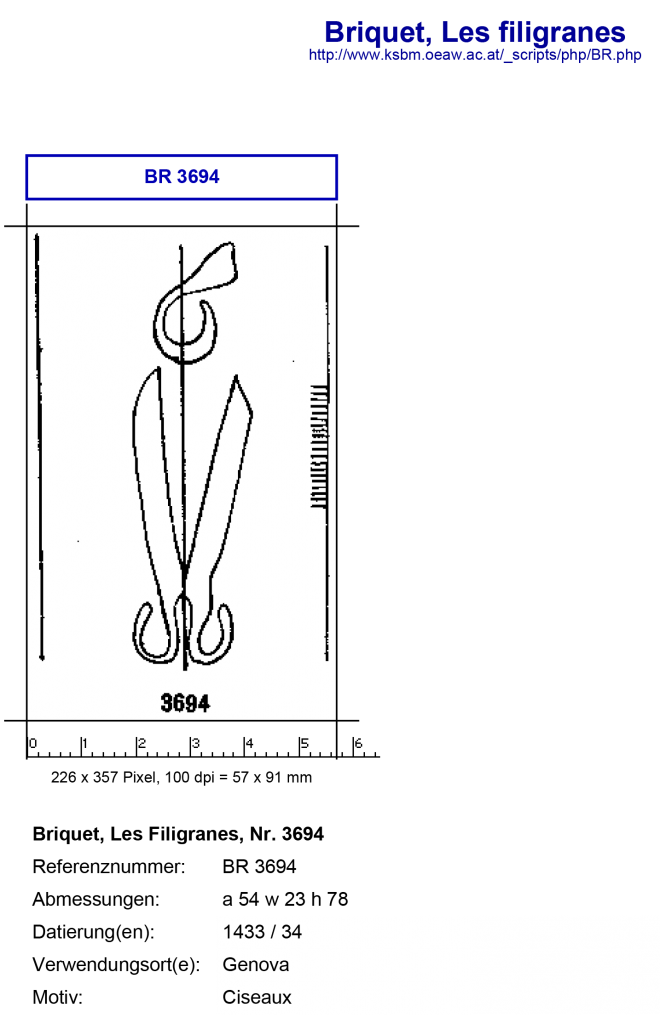
Briquet 3694 Scissors with Letter G.
For Watermarks 2 and 3 in the newer section, see
- Specimen V.3.3.1. Crescent Surmounted by a Crown of 5 Rays and Suspended from a Cross
- Specimen VII.1.1.2. Glove with Tapered Cuff Ending in Rippled Edge
*****
Subgroup IV.1.2. Balance or Set of Scales
Specimen IV.1.2.1. Balance within Circle
Arabic Manuscript dated by colophon to 1492 CE (= AH 898)
Based on that date, as well as other examples of related watermarks, it looks as though the watermark was some 10–20 years old when the manuscript was written. The manuscript is incomplete, missing an unknown number of leaves or quires at the beginning. The cardboard binding, in poor condition, is probably 19th-century.
Script Sample with Colophon
Title: “bism al Kitab bi-afr Allal al-Malik al-wafamar ‘Ali yarazaf al-‘Aba”.
Scribe: “al-Mustafi”.
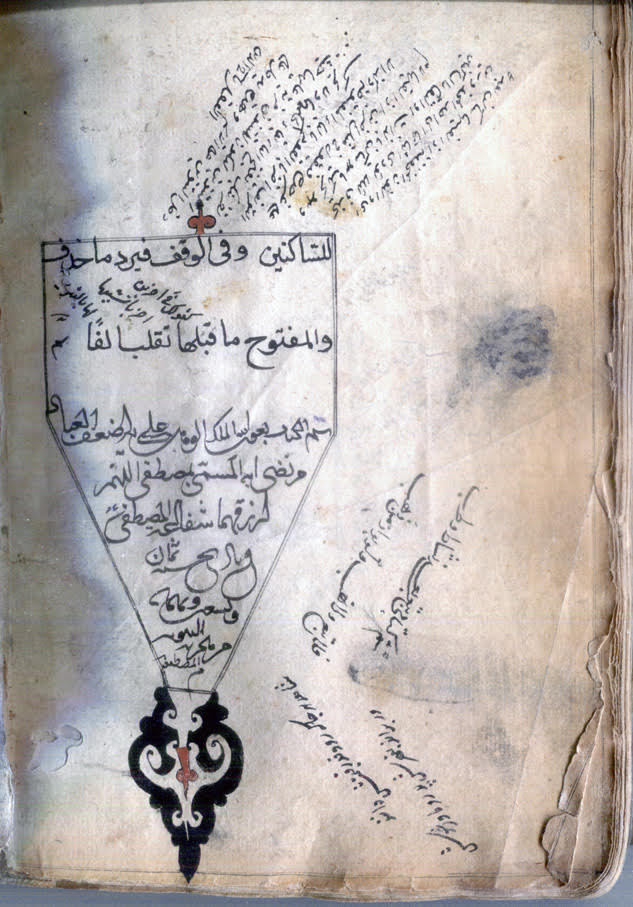
Colophon of Arabic AH 898.
Watermark
Relatives
Briquet 2472 or similar, with “sightings” in the date-range of 1463–1482, but here used rather later.
Balance | inscrite dans un cercle | à plateaux concaves
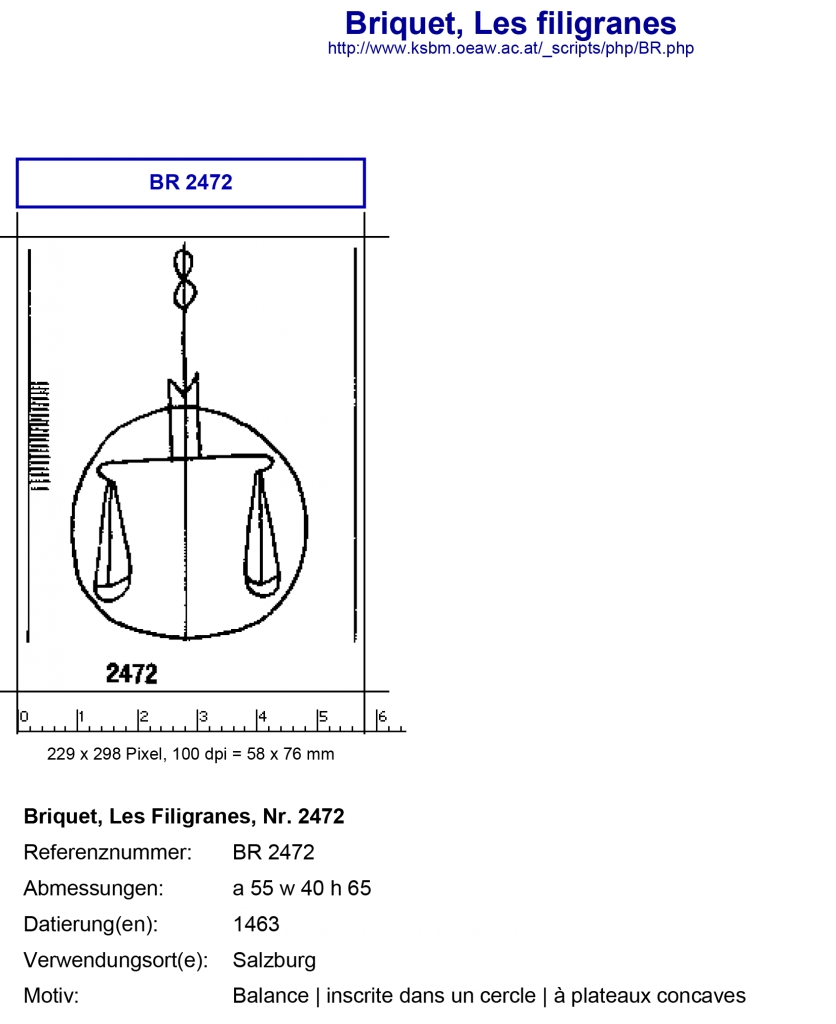
Briquet 2472 Balance with concave pans.
*****
Specimen IV.1.2.2. Balance on a Chain within a Circle
Private Collection, “Turkish Binding Fragment”, undated.
Binding fragment from a Turkish manuscript, without a date. Nothing in Briquet matches all the elements of the design.
Script Specimen
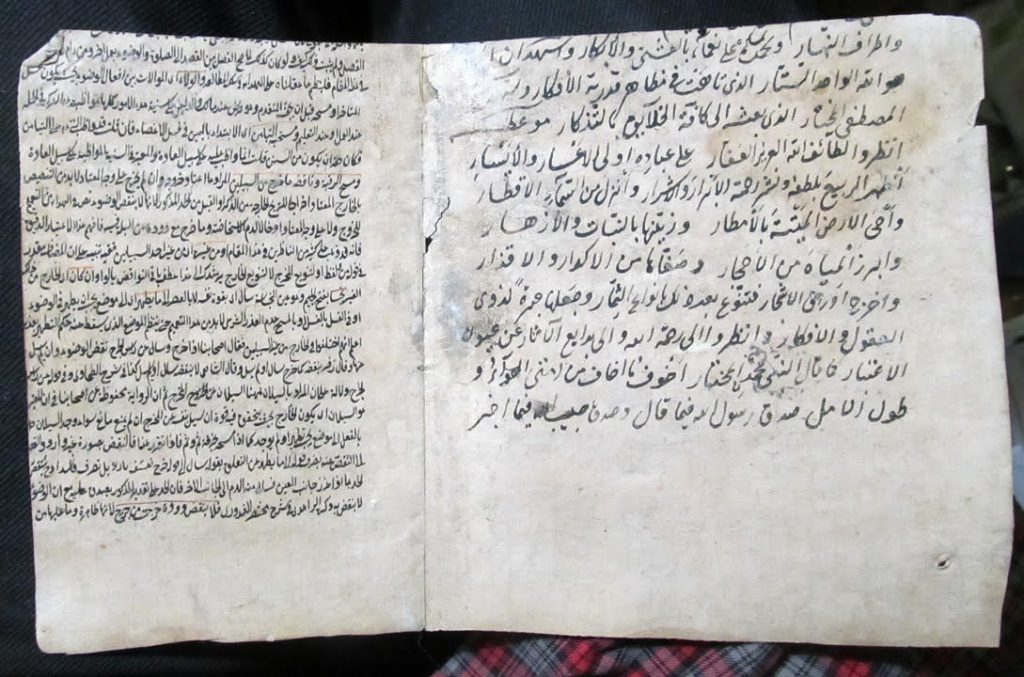
Turkish Binding Fragment with Balance Watermark.
Watermark: Balance, without close relative in Briquet
Enclosed within a circle, the balance is suspended from a twisted chain which rises some distance above the circle. The balance has a horizontal beam, an M-shaped fulcrum, and concave pans suspended by triple cords.
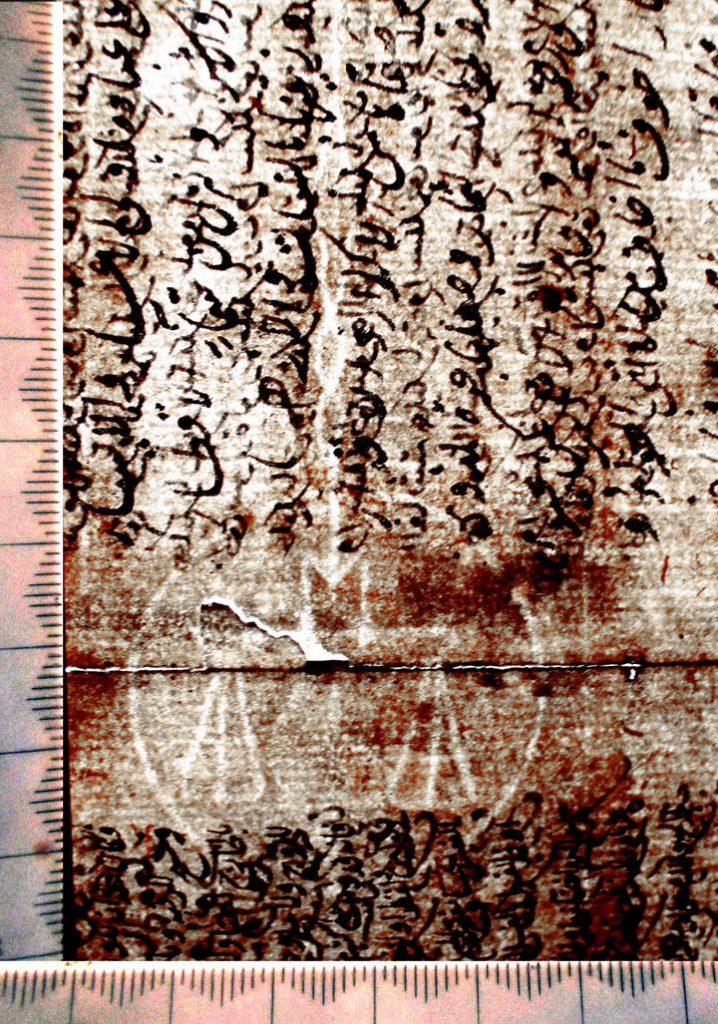
Balance Watermark.
Another view:
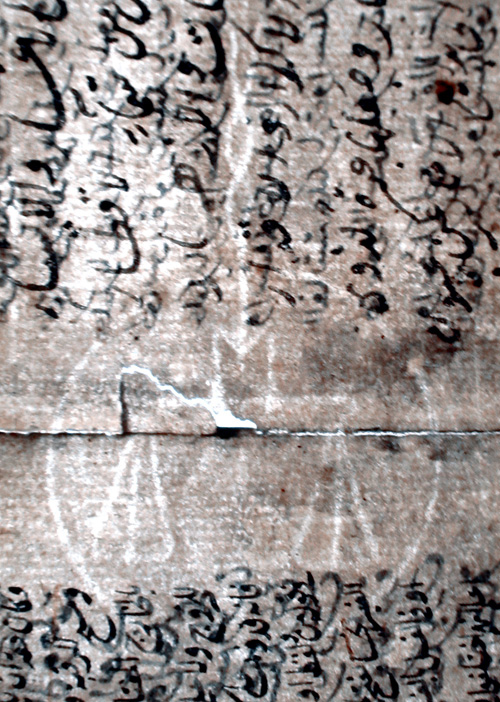
Relatives
Some comparanda: Briquet Balance.
Among the variations of this genre, some distant relatives fall among those “inscrite dans uns cercle | à plateau concaves” (Nos. 2472–2485). Most of these similar designs have “sightings” in the 1470s–90s.
*****
Motif Subgroup IV.1.3. Bell
See below: Mystery Sample 1. Bell? in Oval
*****
Motif Subgroup IV.1.4. Anchor
Specimen IV.1.4.1. Anchor within Circle
Identifier: Private Collection, Fragment of Latin Jenson Bible printed in Venice in 1479.
Biblia Latina, printed in Venice : Nicolaus Jenson, 1479. – f°. – ISTC ib00563000
(Electronic fasimile of a Munich copy here)
Watermark
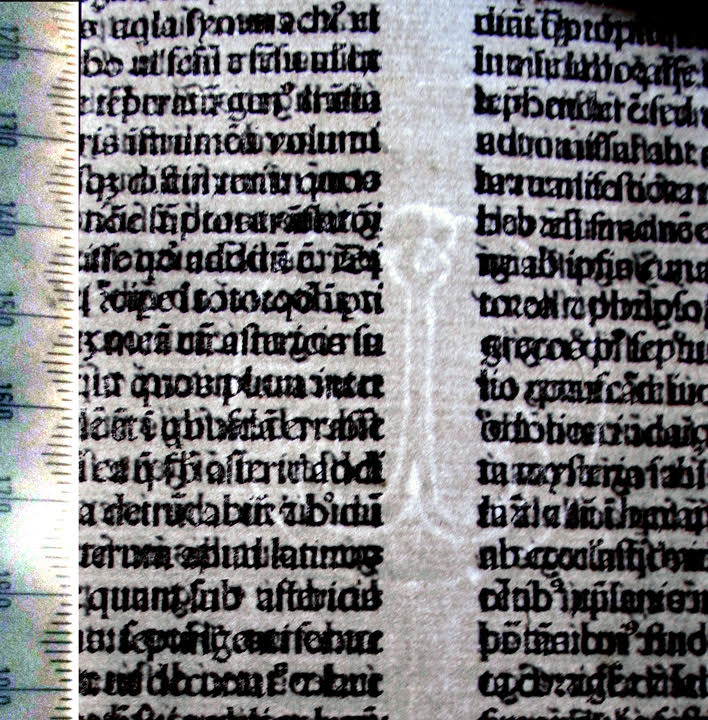
Anchor Watermark in Bible printed in Venice 1479.
Relatives
Closest match: Briquet 459, “Wien 1499” (but not identical)
Ancre | inscrite dans un cercle | accompagnée d’un anneau
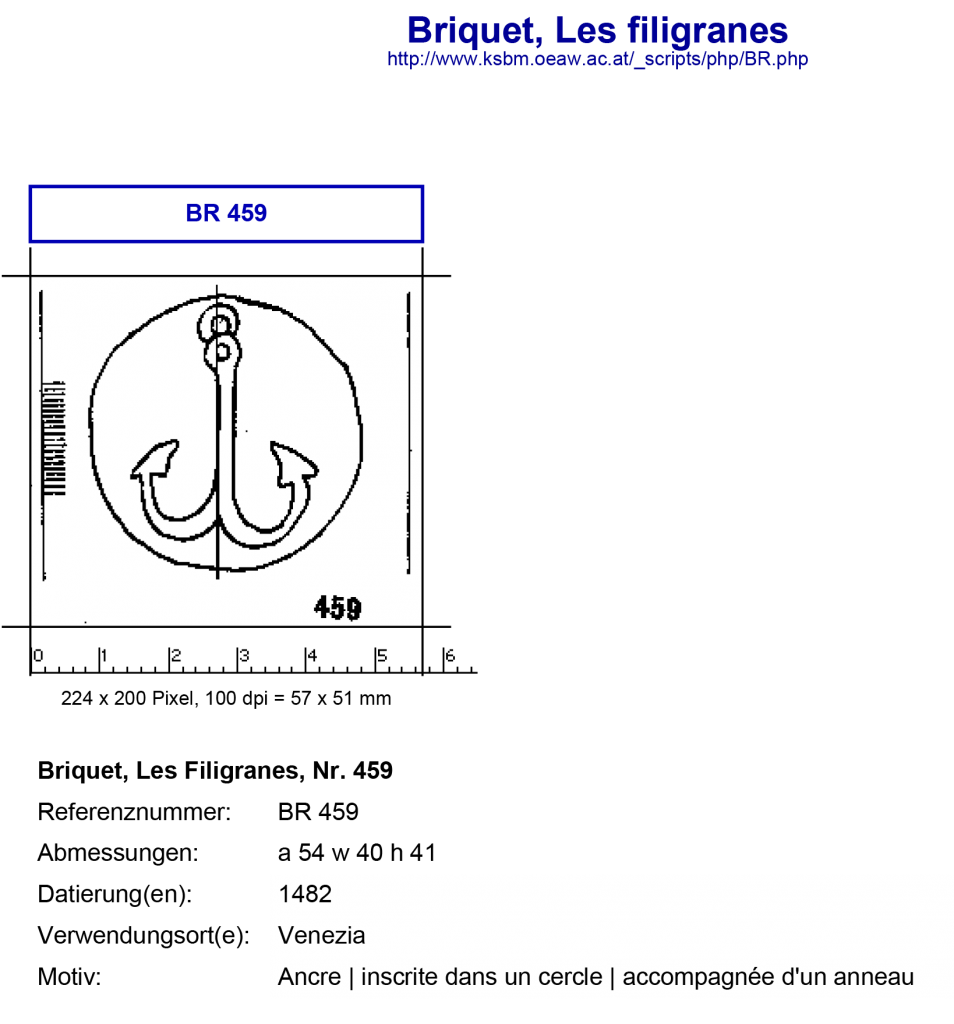
Briquet 459 Anchor.
See Piccard Online: Anchor
A Note on “Watermark Wire”
Like some other watermarks (such as the Haro watermark of a gloved hand, shown below), this mark is attached to a wire which appears to be a chain line, but is not. Unlike the chain wires, it was not attached to the screen, because it has no pulp drift.
Note, in the detail below, the pulp-drift around the outer lines, but none around the middle chain-line, to which the watermark was attached. Maybe such treatment can be localized to time and place.
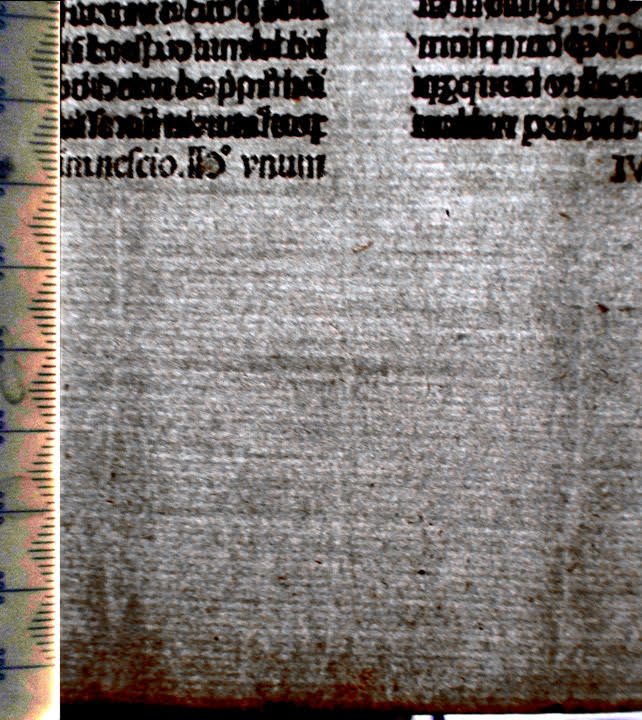
Paper of Bible printed in Venice 1479.
*****
Motif Group IV.2: Weapons
Subgroup VI.2.1. Bow and Arrow
Specimen IV.2.1.1. Bow and Arrow:
Upright, with Recurving Double-Contoured Bow and Chevron-Shaped Arrowhead
Private Collection, Marriage Contract in French from Le Thore in the diocese of Cavaillon, dated 26 January 1416.
Script Specimen: Page 1 of the contract.
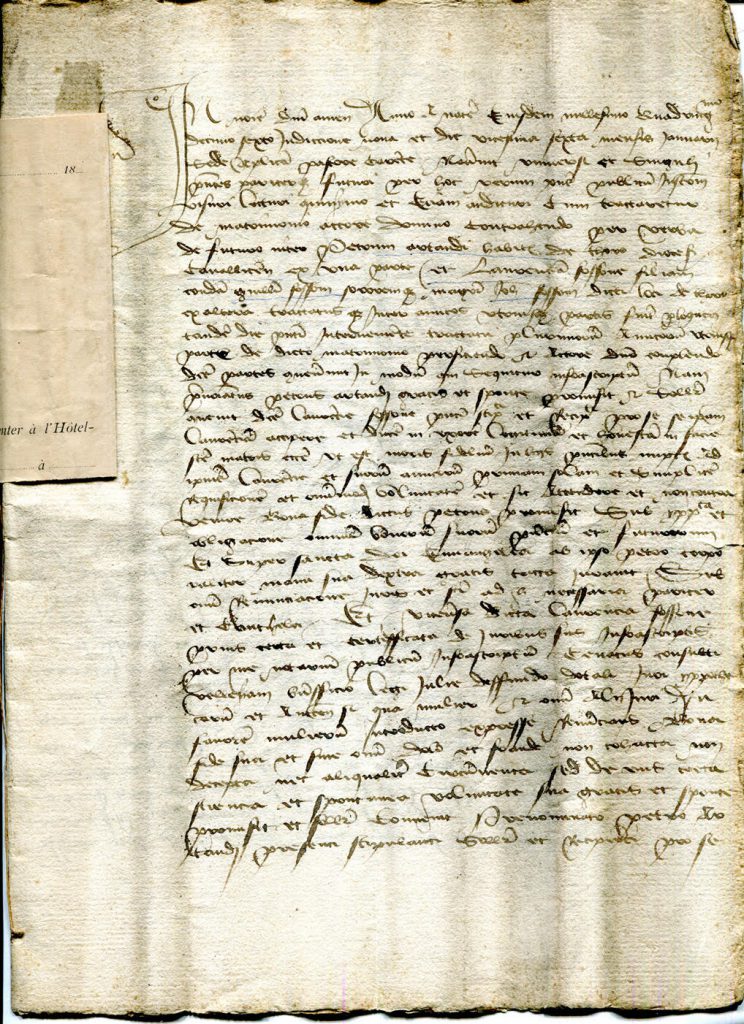
Private Collection, 1416 French Marriage Contract Page 1.
Attached Note

Private Collection, Note Pasted to 1416 French Marriage Contract Page 1.
Watermark
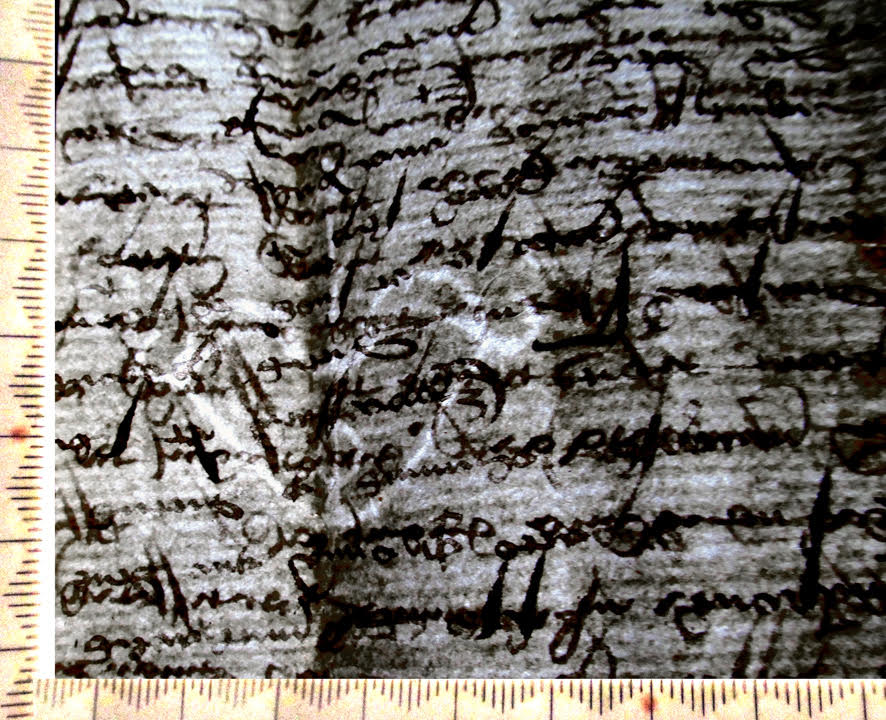
Bow-and-Arrow Watermark in 1416 French Marriage Contract.
Equivalent
= Briquet 810 “Draguignan 1412”.
Arc | pointe de la flèche en accent circonflexe
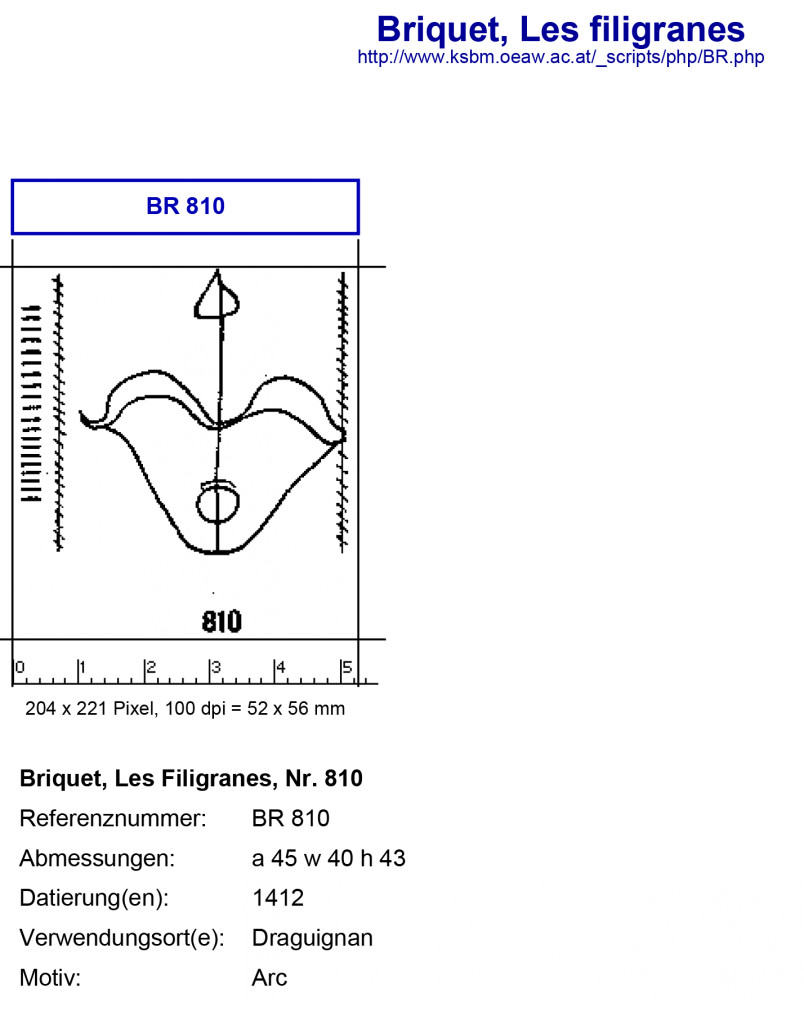
Briquet 810 Bow and Arrow.
*****
Specimen IV.2.1.2. Bow and Arrow, Upright, with Recurving Bow and V-Shaped Arrowhead
Identifier: Private Collection, 15th-century Composite Theological Manuscript in 2 Parts, from Le Parc Abbey, Belgium.
See A 15th-Century Theological Volume from Le Parc Abbey.
Part A, Section B of the Composite Volume. Quire of 3 originally blank bifolia (folios 92–97 of Quire 8), with the medieval folio numbering “3–7”, following Quires 1–7 of the theological Compendium of “Albert Magnus” — which have a different watermark (see below, “Double-Headed Eagle”).
Script Sample
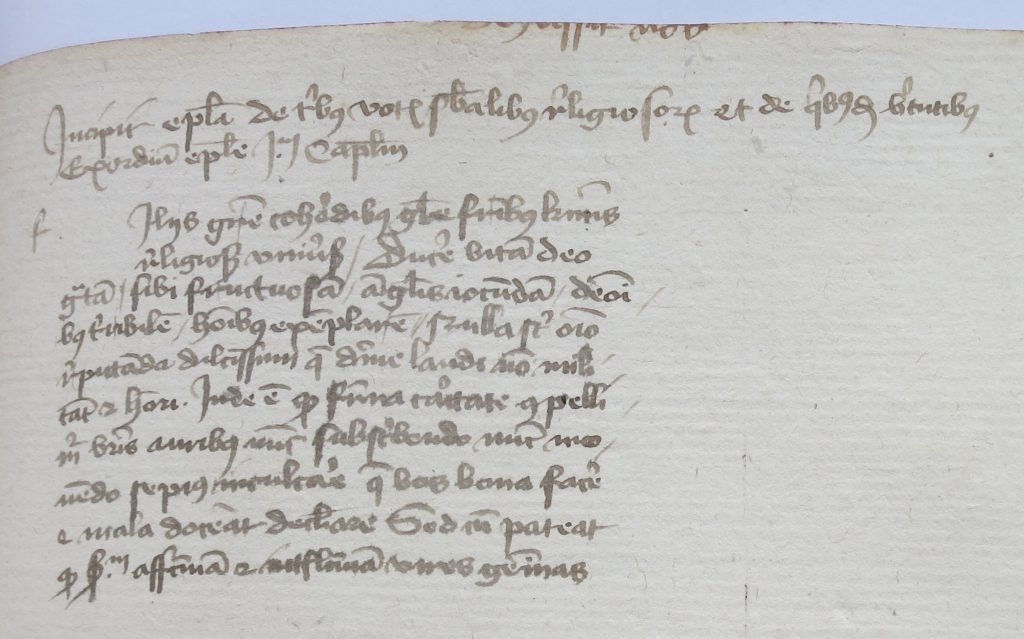
Private Collection, Le Parc Abbey Theological Volume, Part A, Section 2: Folio 93r, top.
Watermark
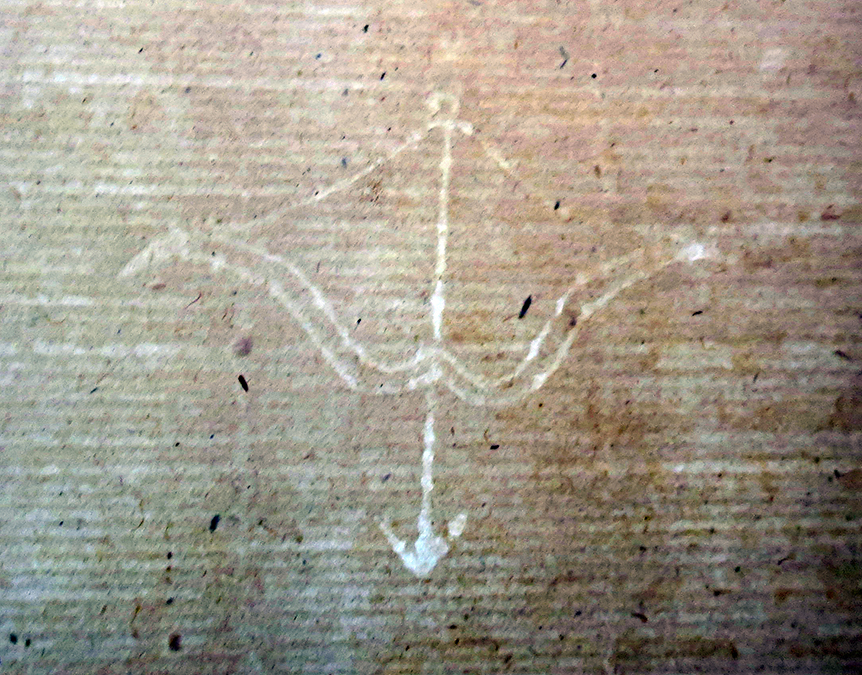
Part A, Section 2, Watermark. Folio 96 detail.
Relatives
Nothing close in Briquet.
A closely related example occurs in an illustrated Watermark from the Islamic Manuscripts collection at the University of Michigan: Isl. Ms. 78, Page 38
That specimen features a bow and arrow motif similar to no. 12346 of the Piccard Watermark Collection [1].
Realien – Waffen – Bogen (Waffe) – frei, senkrecht – zweikonturig, ohne Beizeichen
*****
Motif Group IV.3. Staffs / Symbols of Office
Subgroup IV.3.1. Crook or Crosier
Specimen IV.3.1.1. Crook or Crosier with Bulb-Like Terminal (= Briquet 5782?)
Identifier: Detached leaf from “Otto Ege Manuscript 51”, a copy of Aristotle’s Nichomachean Ethics and commentary in Latin translation, formerly in 3 volumes and containing sections or “booklets” produced at different times and in different centers, with at least 3 different colophons.
See More Leaves from ‘Otto Ege Manuscript 51’
Script sample
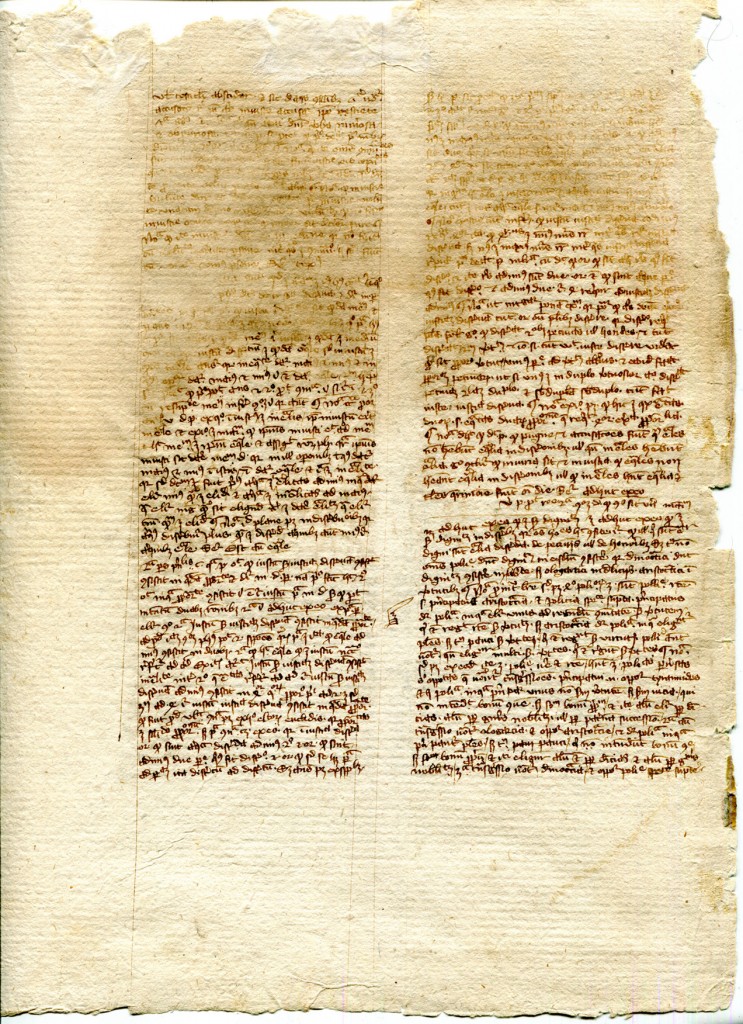
Verso of detached leaf from the Nichomachean Ethics in Latin translation, from a manuscript dispersed by Otto Ege and now in a private collection. Reproduced by permission.
Watermark with back-lighting and scale
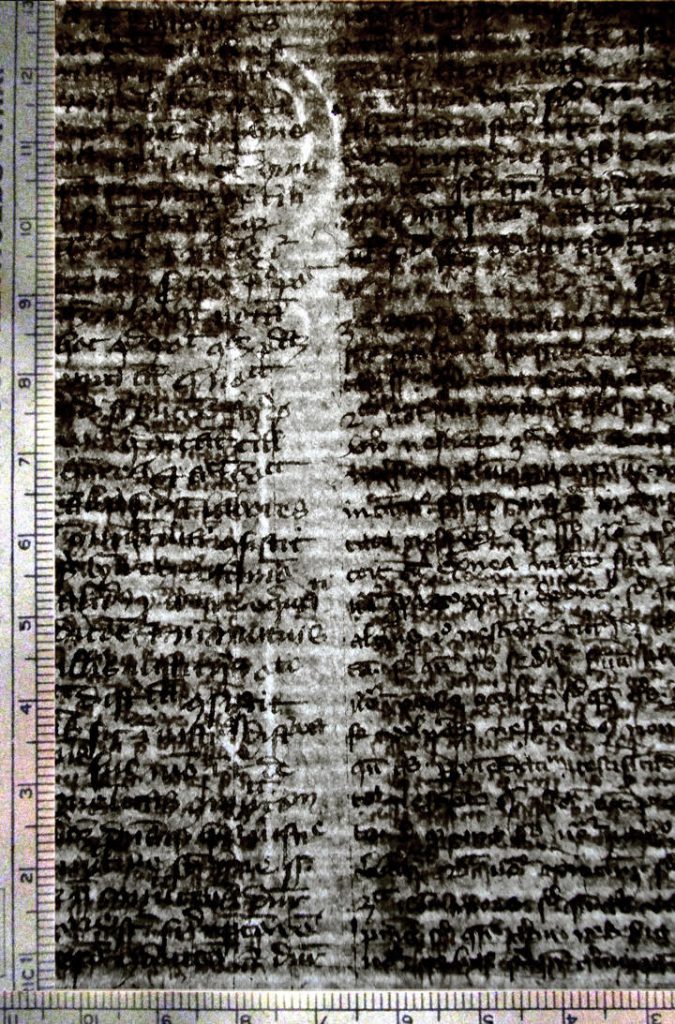
Private Collection, ‘New Leaf’ from Ege MS 51, Crosier Watermark with Scale.
Equivalent
= Briquet 5782
The watermark comprises a fairly simple, upright crook or crozier. Its specific representative in Briquet’s Dictionnaire historique of watermarks appears as one of the specimens under the classification of Crosse (French for “shepherd’s staff”, “crook”, or “crozier”): Briquet Number 5762, citing a dated example of 1369 CE. Taken together, the case of this leaf specimen and the colophon of its manuscript permits an earlier dating of the use of this paper stock by 4 years.
The crook or crozier takes the form of a hook curled through nearly one complete revolution to a bulb-like terminal, with a stubby “hilt” or stopper below the angular turn at the base of the curl. Because such a form would not serve a shepherd’s purpose in the field for catch and release of a sheep’s extremities, we ought not think of it as denoting a shepherd’s staff or crook, but as a cozier of some sort, comprising a staff of office.
*****
Motif Group IV.4. Vehicles
Subgroup IV.1.1. Chariot or Cart
Specimen IV.4.1.1. Char (2-Wheeled Chariot or Cart)
Identifier. Private Collection, Undated Turkish Manuscript of 5 leaves with 2 Watermarks (Fleur etc.)
[See above, Specimen I.3.1: Fleur-de-lys]
Type of Text: Hadith Commentary in single columns
Script sample (see above, Specimen I.3.1: Fleur-de-lys)
Watermark
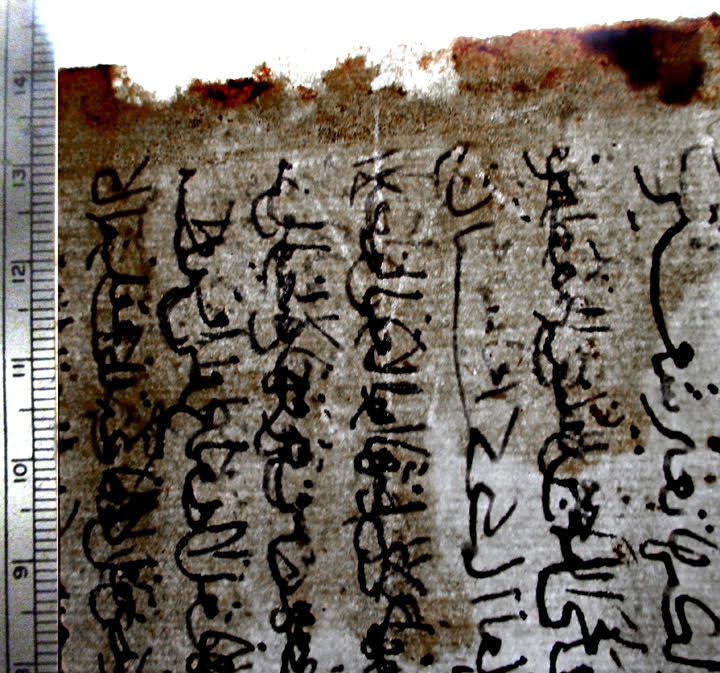
Private Collection, Hatith Commentary, Another watermark, perhaps ‘char’ and B 3544
Relatives or Equivalent
Perhaps = Briquet 3544 “Lucca 1344”
Char | à deux roues
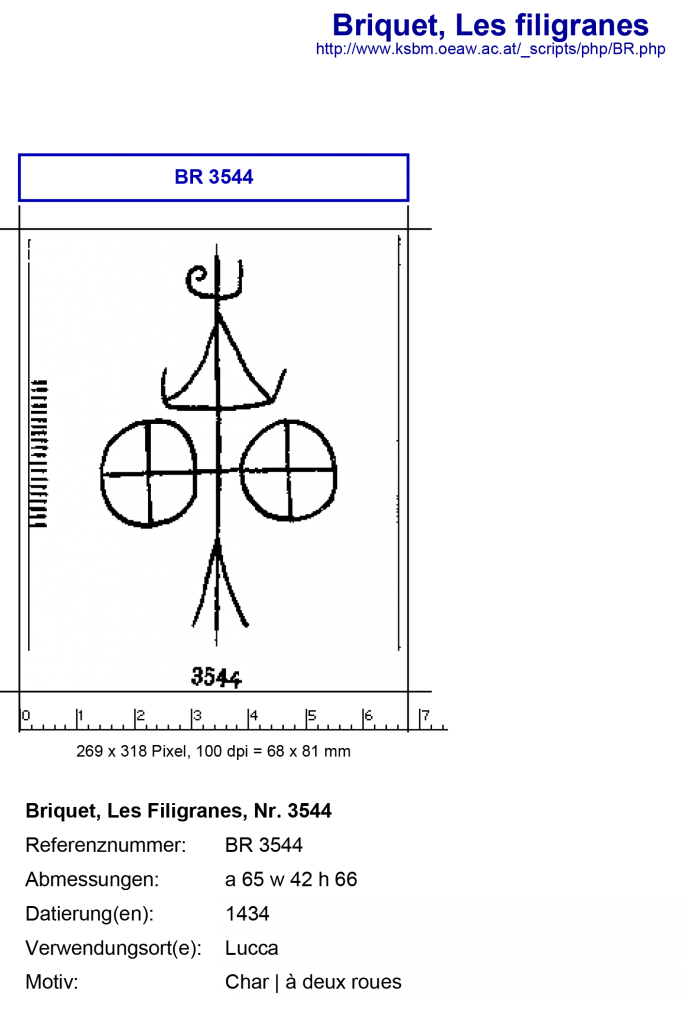
Briquet 3544 2-Wheeled Cart or Chariot.
See also Type 20. Carro a due ruote, in”8 varietá dal 1414 al 1458″, among Le filigrane delle carte genovesi .
A Note on Job-Lots
The collector observes that “I’m tempted to speculate that these watermarks are so mixed because the paper consisted of remnants of job lots left over from printing projects, which were then collected from the printers and sold by the ream elsewhere, perhaps in the Levant. No real evidence, just guesswork. It might explain the appearance of so much Italian paper in the Levant, as this sort of lot would have probably been a lot cheaper than paper directly from the mills.”
*****
Motif Group IV.5. Architectural Elements
Subgroup IV.5.1. Column
Specimen IV.5.1.1. Architectural Column Surmounted by a Latin Cross
Identifier: Private Collection, Fragments of Spanish Capbreu in Latin and Catalan from a castle in Catalonia, Spain — perhaps at Castelví de la Marca, at Alt Penedés, Barcelona.
This portion comprises 28 leaves; they are mostly bifolia, plus a folded full sheet. The dated entries extend from 13 to 25 September 1489. Here is a first report .
Language: Latin and Catalá
Script Sample
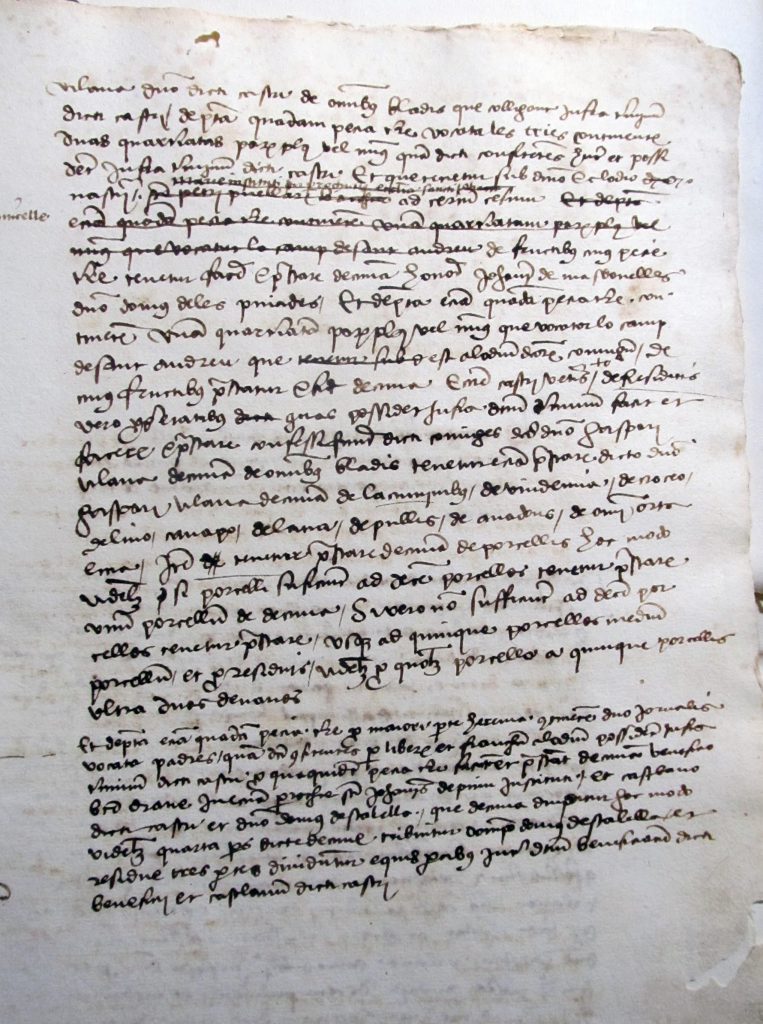
Private Collection, Castle Cartulary, Spain, Script Sample.
Watermark
The fragment has consistent watermarks of an upright column topped by a cross (= Briquet 4361).
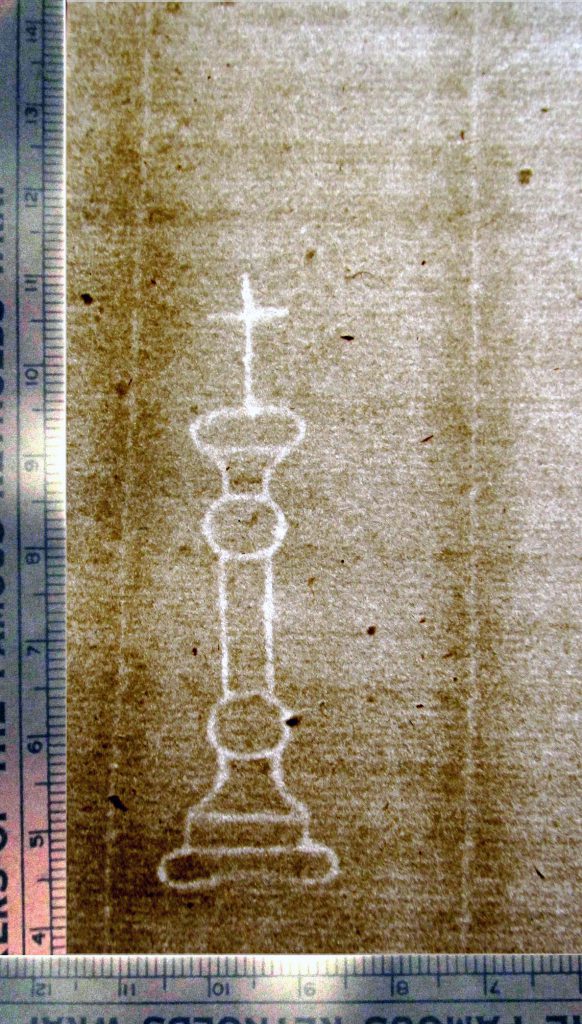
Private Collection, Castle Cartulary, Spain, Watermark of a Column.
Relatives or Equivalent
= Briquet 4361 “Narbonne 1488”
Colonne | surmontée d’une croix
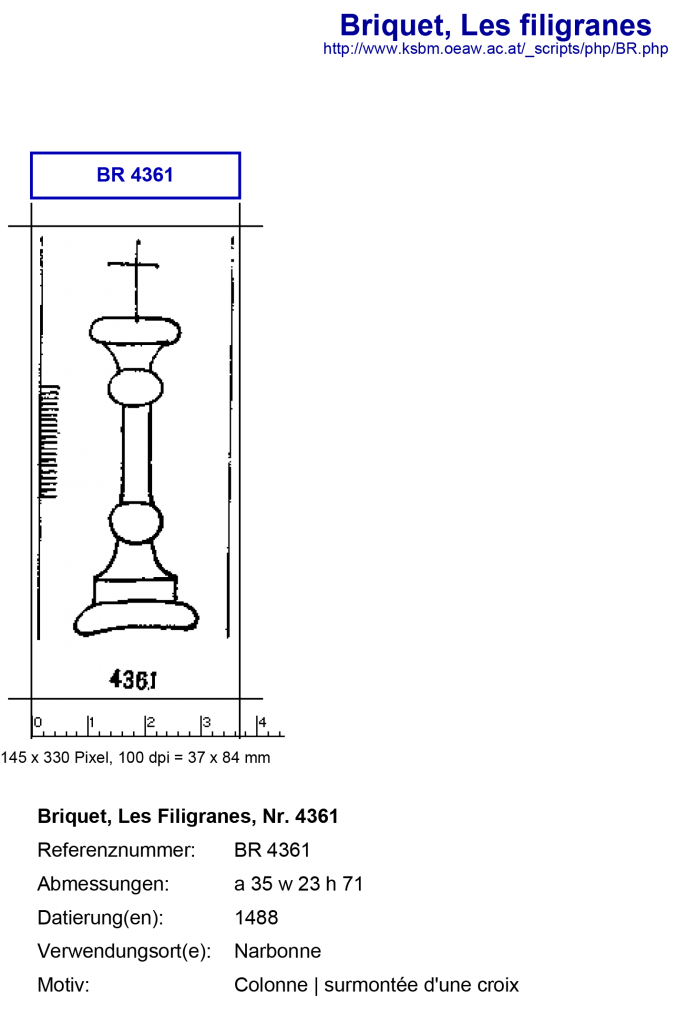
Briquet 4361 Colonne.
*****
Motif Group V. Letters & Figures
Motif Group V.1. Geometric Figures
Subgroup V.1.1. Circles & Ovals
See Specimen III.1.2. 6-Rayed Star in Circle
See Specimen IV.1.2.1. Balance within Circle
See Specimen IV 1.2.2. Balance within Circle
See Specimen IV.1.4.1. Anchor within Circle
See Specimen IV.4.1.1. Char (2-Wheeled Chariot or Cart)
See Specimen VII.2.1. Pilgrim with Staff in Oval
[Etc.]
*****
Motif Group V.2. [Awaiting]
Subgroup V.2.1.
*****
Subgroup V.2.2.
[Awaiting]
*****
Motif Group V.3. Figures, Marks & Symbols
Subgroup V.3.1. Cross
See Specimen IV.5.1.1. Column Surmounted by a Latin Cross
See Specimen V.3.3.1. Inverted Crescent Surmounted by Crown of 5 Rays and Suspended from Cross
See Specimen VII.3.3.1. Imperial Orb (Reichsapfel) or Circle Surmounted by Cross
[Etc.]
*****
Subgroup V.3.2. Circle
See Specimen I.1.1. 7-Petaled Flower with a Circular Center
See Specimen III.1.2. 6-Rayed Star in Circle
See Specimen IV.1.4.1. Anchor within Circle
See Specimen VII.3.3.1. Imperial Orb (Reichsapfel) or Circle Surmounted by Cross
[Etc.]
*****
Subgroup V.3.3. Crescent
Specimen V.3.3.1. Inverted Crescent Surmounted by a 5-Pointed Crown or Rays and Suspended from a Simple Cross
Identifier. Private Collection, Mamluq Manuscript of Treatise on Islamic Law, in 2 sections. The principal section is mainly on Mamluq-style paper, with a few sheets of watermarked paper. See Specimen IV.1.2.2. Scissors with Curled Letter or Mark (G?). A newer section contains watermarked paper with a different watermark (“Watermark 2”).
Script Sample
See above.
Watermark 2
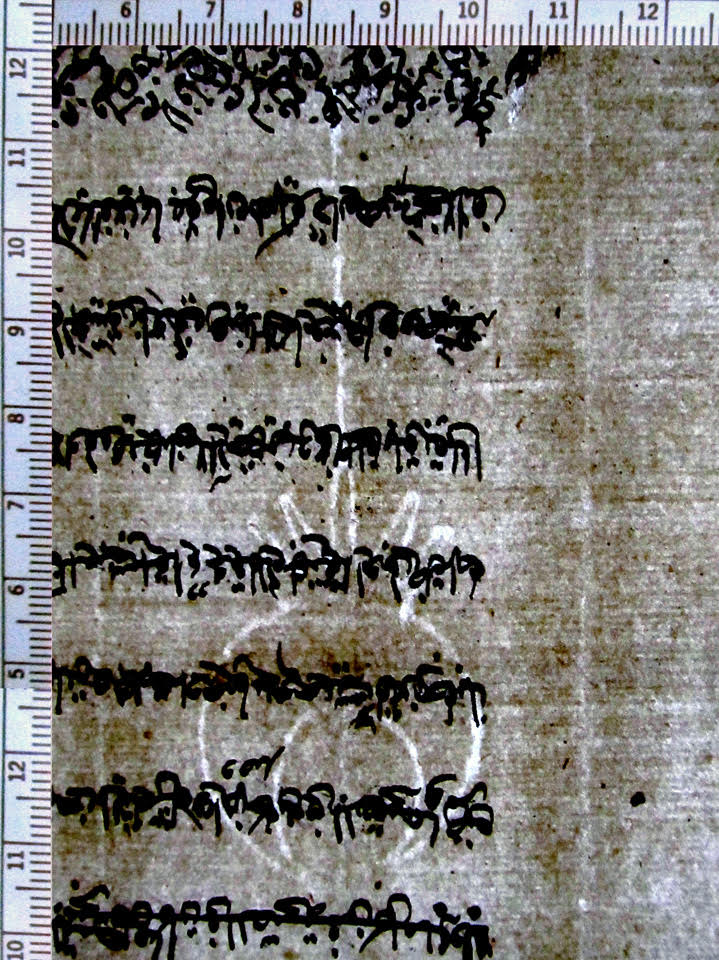
Private Collection, Treatise on Islamic Law, Newer Section with watermark of Crescent with Crown or Rays on Cross..
Comparanda
Briquet 5220. “Fabriano 1412”. 1430s.
Croissant | les pointes tournées en haut ou en bas | couronné ?
See also Specimen IV.1.2.2. Scissors with Curled Letter or Mark (G?)
*****
Subgroup V.3.4. Three Crescents (“Tre Lune” or “Trois Croissants”)
Specimen V.3.4.1. Three Crescents in a Descending Row
Identifier. Private Collection, Turkish Manuscript Fragment with usual 3-Crescents watermark
Script Sample
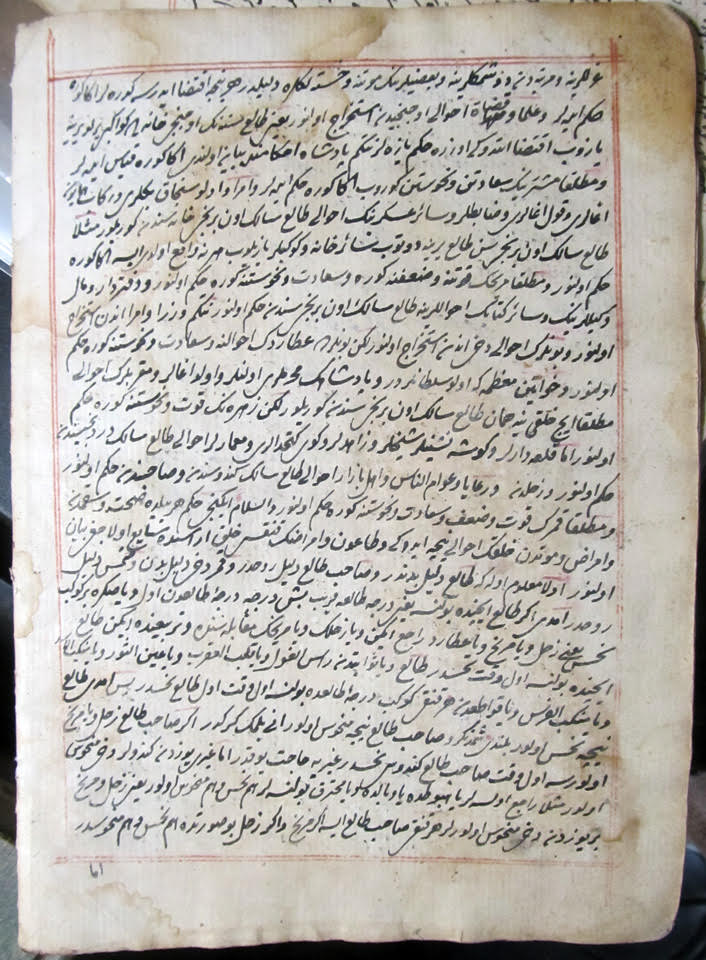
Private Collection, Turkish Manuscript Leaf with usual 3-Crescents Watermark.
Watermark
In their horizontal row of 3, placing their pointed side toward the curved back of the next, the crescents reduce in size in a series from largest at the outer side.
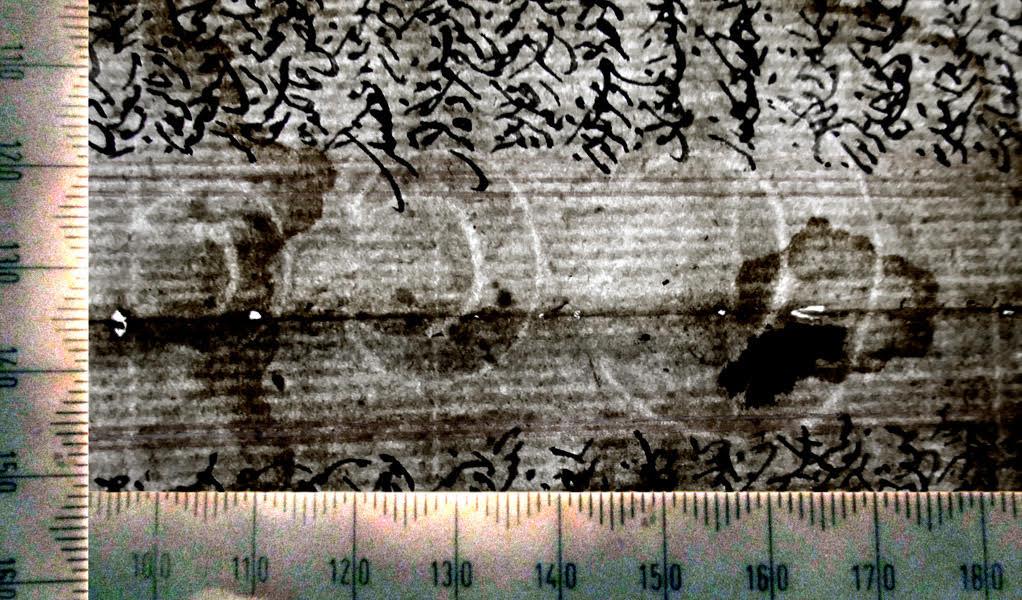
Private Collection, Turkish Manuscript Leaf: 3-Crescents Watermark.
Comparanda
A Note on Tre-Lune Watermarks
Watermarks in the form of 3 Crescents (Tré Lune, Trois Lunes, Trois Croissants, etc.) standing in a row occur plentifully in Italian, and especially Venetian, paper-manufacturing of the 17th and 18th centuries. Marketed to various regions of the Ottoman Empire, paper with this type (in one form or another) found widespread distribution and use in manuscripts and documents. Overall, it is one of the most frequent to appear in Islamic materials.
Some information and comparanda:
-
-
- Asparoukh Velkov and Stephae Andreev, Filigranes dans les documents ottomans, I: Trois Croissants (1983)
- Alan D. Crown, Samaritan Scribes and Manuscripts (2001)
- Beate Wiesmüller, The Watermarks from the Refaiya Library, translated by Steven Black
- Coptic Prayers on Venetian Paper
- U-M Special Collections Research Center, University of Michigan, Watermark Wednesdays: Three Crescents (August 27, 2014)
-
[Etc.]
*****
Specimen V.3.4.2. Crescent in Version of “Man-in-the-Moon-in-Shield”
Identifier. Private Collection, Coptic / Arabic Manuscript Fragment.
Script Sample
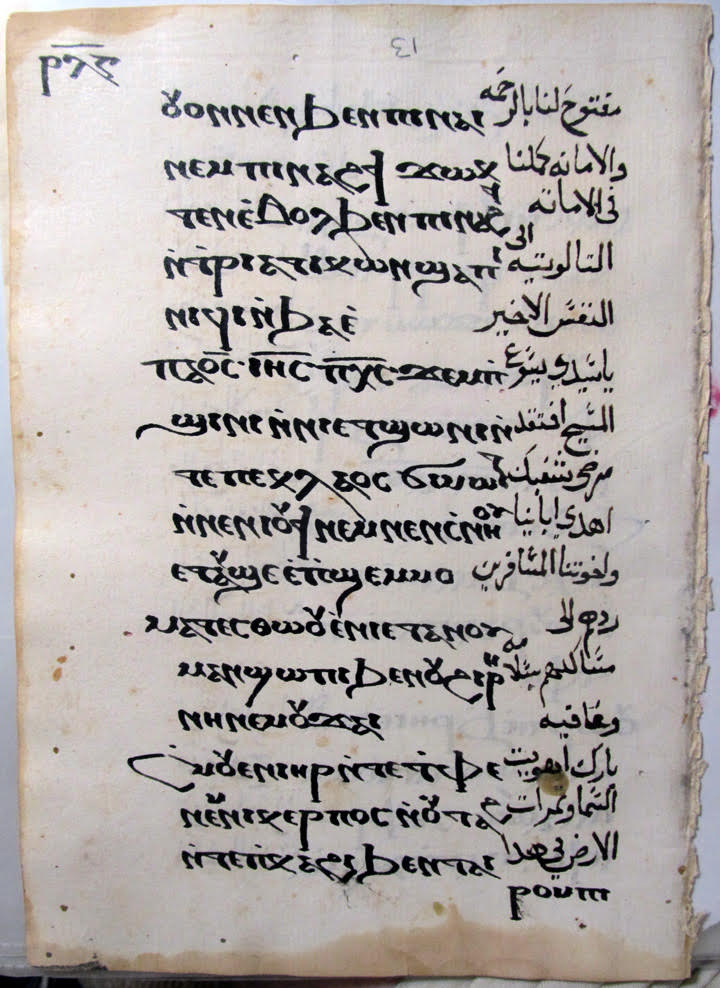
Private Collection, Coptic / Arabic Manuscript Fragment.
Watermark
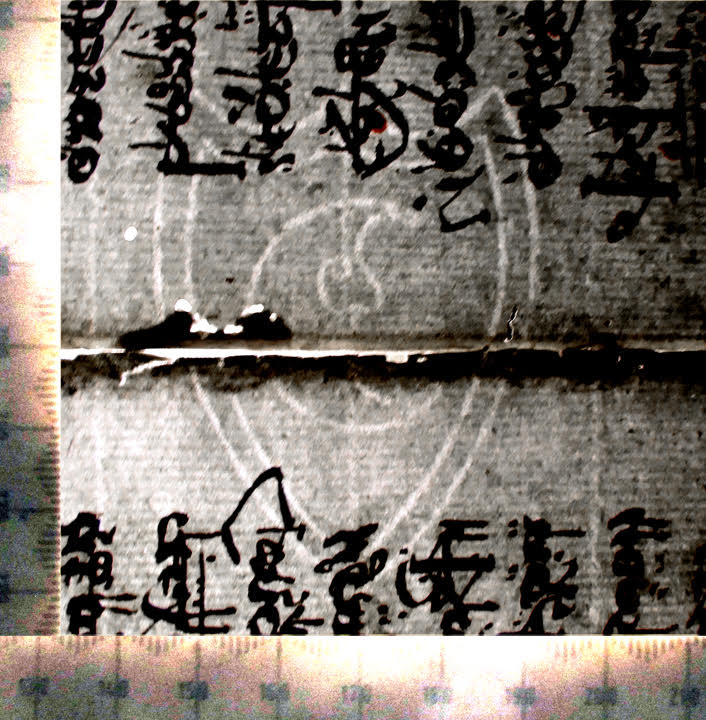
Private Collection, Tre Lune watermark in late version of man-in-the-moon-in-shield.
This type of mark ranges from “late” to “very late”, that is, as late as ground-wood pulp “laid” paper.
Comparanda
[Awaiting]
*****
Subgroup V.3.5. Letters or Marks
See Specimen IV.1.2.2. Scissors and Curled Letter or Mark (G?)

Private Collection, Mamluq Treatise on Islamic Law, Section of a few sheets with watermark of Scissors with G.
See Specimen VII.3.3.1.2: Imperial Orb Surmounted by Letter P?
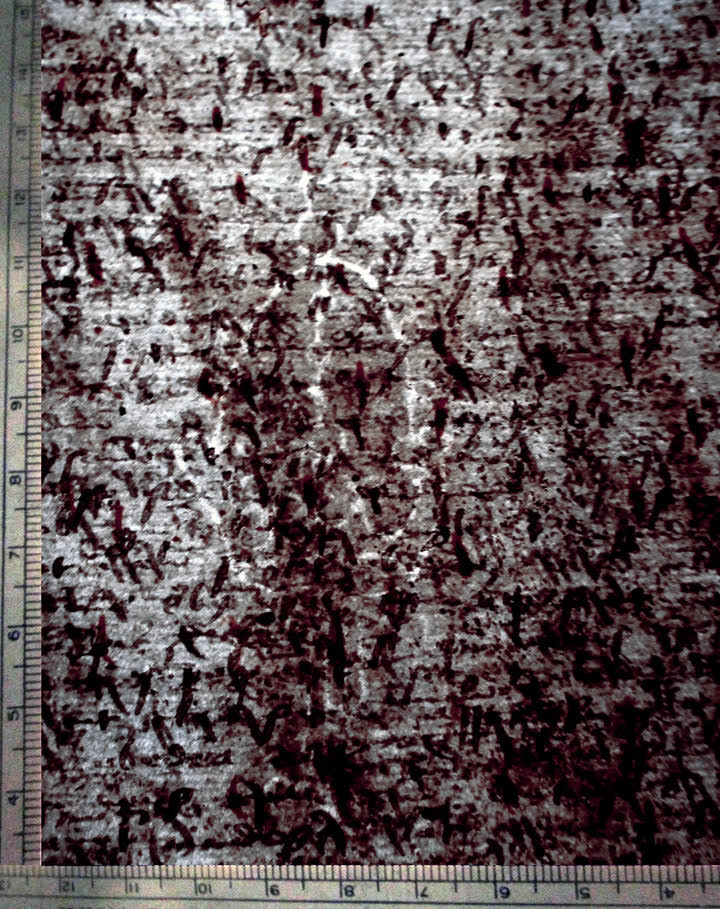
Private Collection, Greek Manuscript Fragment retrieved from reuse as part of the binding of a Hebrew book printed circa 1530 in Salonica. Watermark.
See Mystery Sample 6: Row of Letters or Figures?

Private Collection, Islamic Manuscript Fragment from Lebanon, Watermark.
*****
Subgroup V.3.6. Numbers
[Awaiting]
*****
Motif Group VI. Non-Anthropomorphic Figures: Animals, Birds, Etc.
Motif Group VI.1. Birds
Specimen VI.1.1. Double-Headed Eagle, Displayed
Private Collection, Composite 15th-century Manuscript from Le Parc Abbey, Belgium.
See A 15th-Century Theological Volume from Le Parc Abbey.
Part A, Section A. Quires 1–7 (folios 1–91). Theological Compendium attributed to “Albertus Magnus”;
namely Hugo Ripelin, Compendium theologicae veritatis in septem libros digestum
[For the watermark in Part A, Section B, see Specimen IV.1.2.1.2. Bow-and-Arrow.]
Script Sample
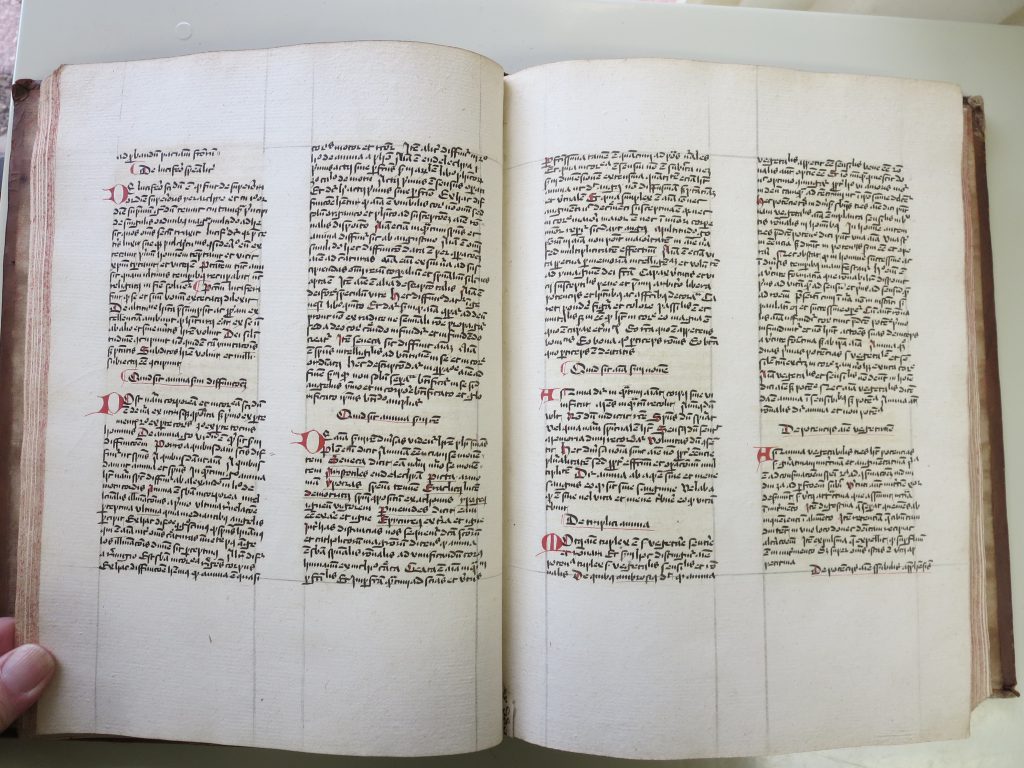
Le Parc Abbey, Theological Volume, Part A, folios 21v-22r. Photograph Mildred Budny.
Watermark
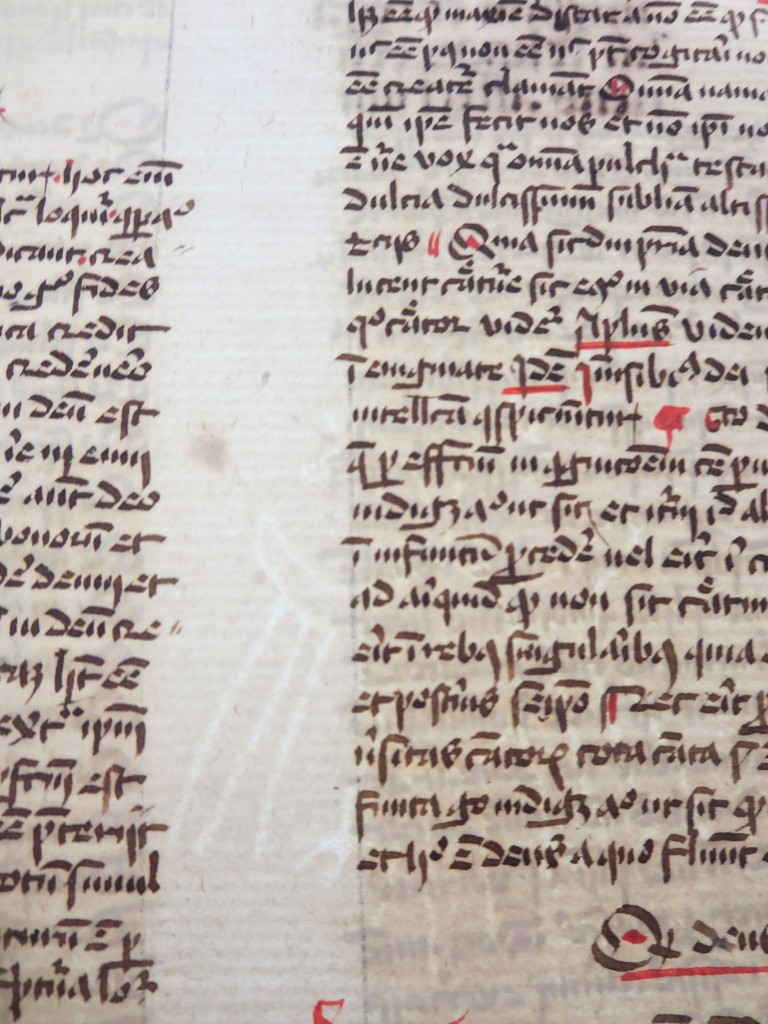
Double-Headed Eagle Watermark.
Relatives
The watermark is somewhat like Briquet Number 230.

Briquet Online, No. 230: Aigle
*****
Motif Group VI.2: Animals (Real, Mythical, Hybrid, Etc.)
Subgroup VI.2.1. Unicorn
Specimen VI.2.1.1. Striding Unicorn with Striped-Pole-Like Horn
Private Collection, Composite 15th-century Manuscript from Le Parc Abbey, Belgium.
See A 15th-Century Theological Volume from Le Parc Abbey.
Budny, Illustrated Handlist, No. 15.
Part B. Folios 97–167 (alternate numbering anew as folios “1”–”70″), arranged in 6 mixed quires (Quires 9–14), comprised of both paper and vellum leaves
Peter the Venerable, Contra Petrobrusianos hereticos
Script Sample
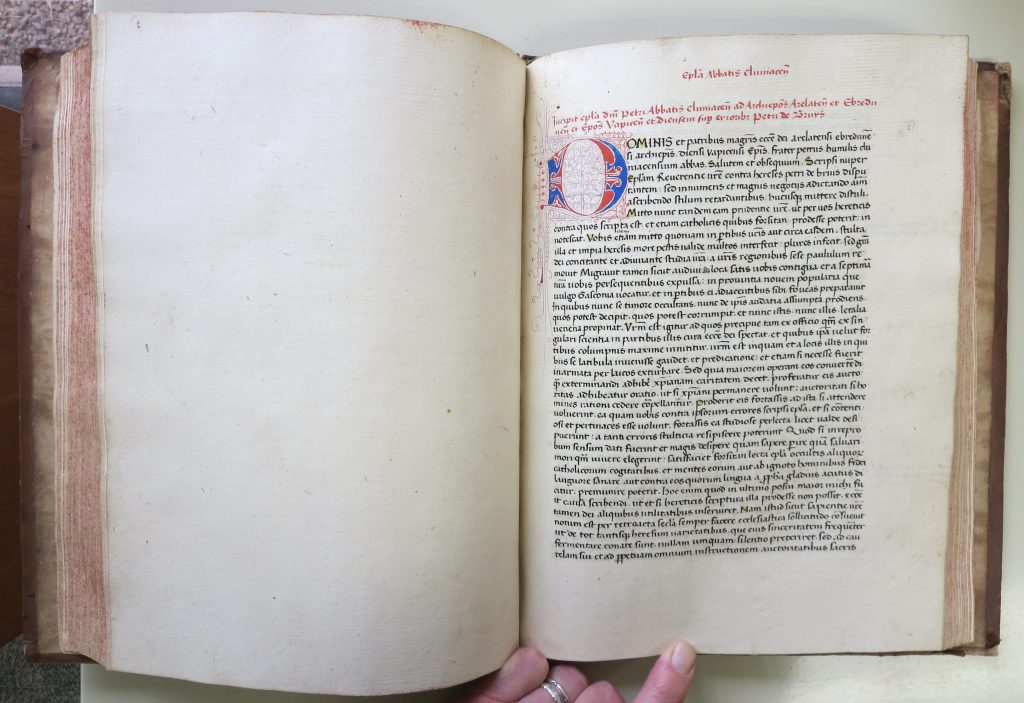
Le Parc Abbey, Theological Volume, Opening between Part A and Part B.
Watermark
[No Image Available Yet]
Relatives
Approximate: Briquet 10016

Briquet Online, No. 10016: Licorne.
*****
Specimen VI.2.1.2. Striding Unicorn with Striped-Pole-Like Horn
Private Collection, Single Sheet with Letter in French, dated only 8 August of an unnamed year (“viii jour d’aougst”). The address panel on the verso names “thesaurier de Laon, chemenier de languierche” or similar. The intended destination designates the Treasurer and the city of Laon in Hautes-de-France, northern France.
The letter is a complete sheet, with address panel on the verso, addressed to the “thesaurier de Laon, chemenier de languierche” or similar. It doesn’t have a year, only “viii jour d’aougst”. The Briquet site has changed its address; it’s now http://briquet-online.at/ which is perhaps easier to remember, but bookmarks need to be updated. In any case there is nothing very close to the unicorn; the closest I have found is 10178, which is not very close, but better than nothing.
Script Sample
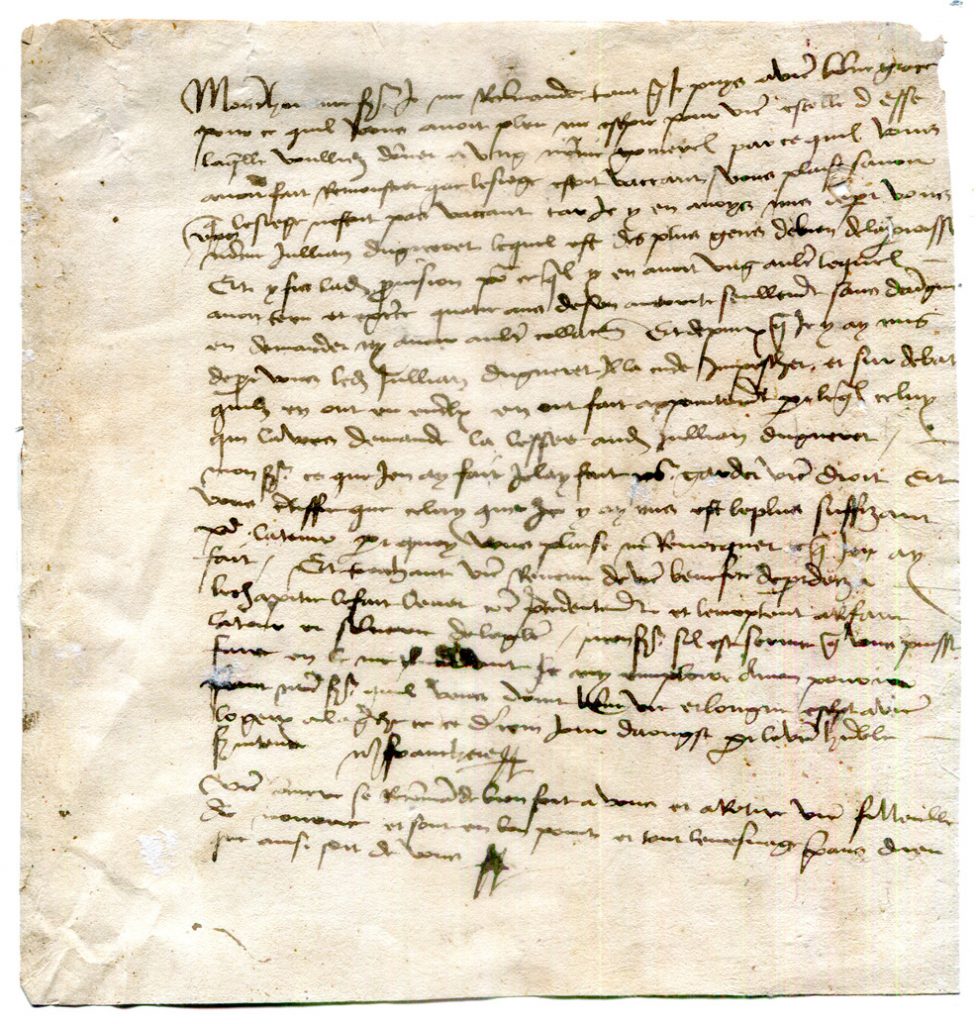
Private Collection, Letter in French dated 8 August of an unnamed year.
Watermark
The creature, shown in a striding pose, has a long body, stubby legs, a tapered tail ending in a pointed tip, a thick neck, small head, a pair of almond-like ears with pointed tips, and a striped horn.
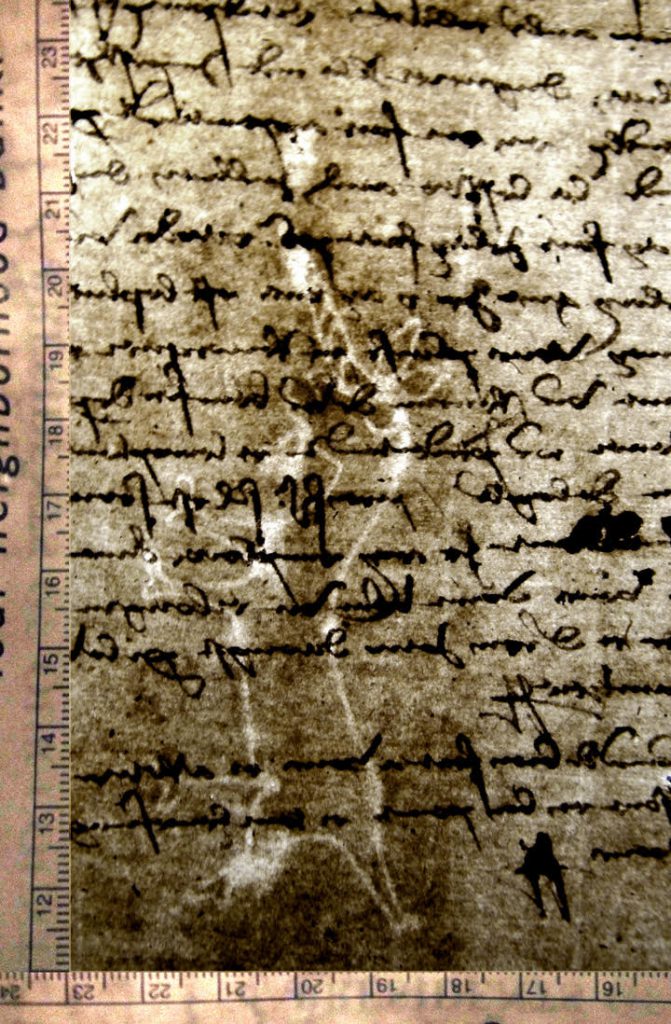
Private Collection, Unicorn Watermark on Letter in French dated 8 August of Some Year or Other. Reproduced by Permission.
Note that the screen used for making the paper is very fine, unusually so. The owner observes: “The very fine screen is curious; it would seem to have possibly been made in somewhere other than the usual Fabriano mills, as the screen is quite unusual. The unicorn looks like a horned ferret as well”.
Comparanda
In Briquet, the owner observes, “there is nothing very close to the unicorn; the closest I have found is 10178, which is not very close, but better than nothing”.
Briquet 10178 looks like this:
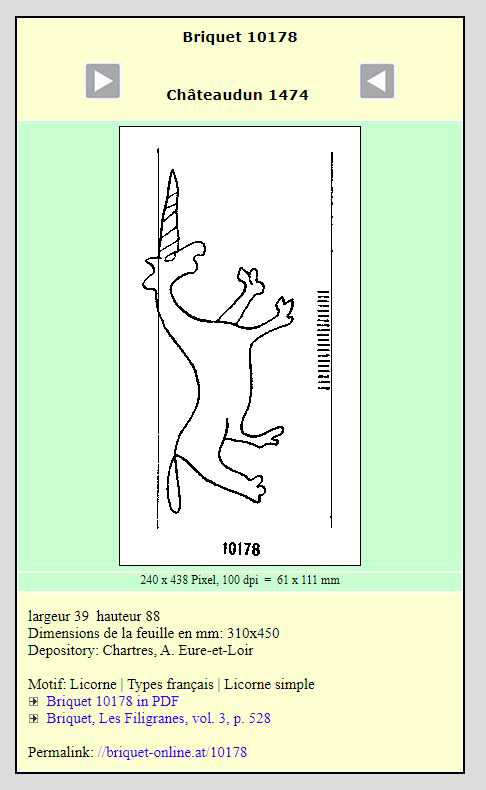
Briquet 10178 Unicorn.
*****
Subgroup VI.2. Bull
See below:
Mystery Sample 2: Filleted Bull’s Head?
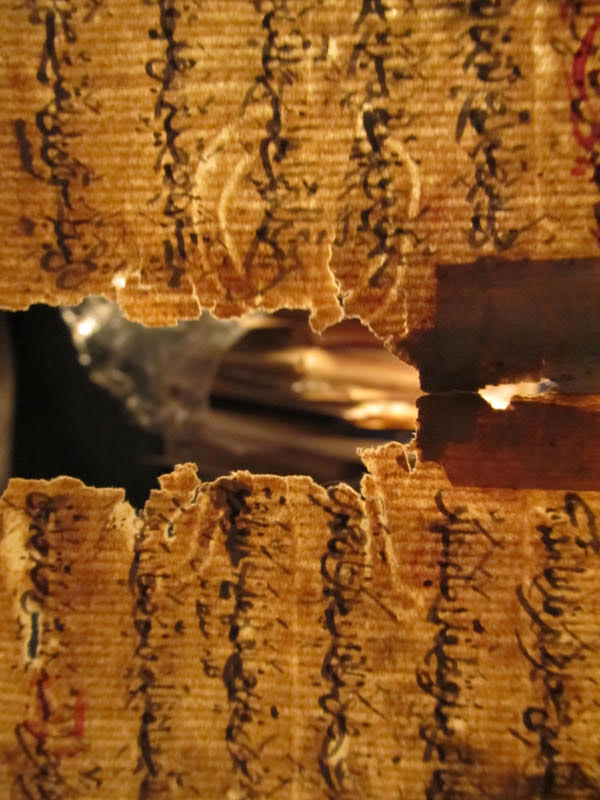
Private Collection, Turkish Manuscript, Watermark perhaps of Filleted Bull’s Head, say 1st Half of 15th century.
*****
Motif Group VII. Anthropomorphic Figures, Full or Partial
Group VII.1. Garments & Accessories
Subgroup VII.1.1. Glove
Specimen VII.1.1.2. Upraised Glove with Tapered and Frilled Cuff
Identifier. Private Collection, Mamluq Manuscript of Treatise on Islamic Law. Undated manuscript, but with a dated reader’s note of AH 860 / CE 1456.
See Specimen IV.1.2.2. Scissors and Curled Letter or Mark (G?) for information about the manuscript and its 3 watermarks.
Script Sample
See above.
Watermark (“Watermark 3” in the manuscript)
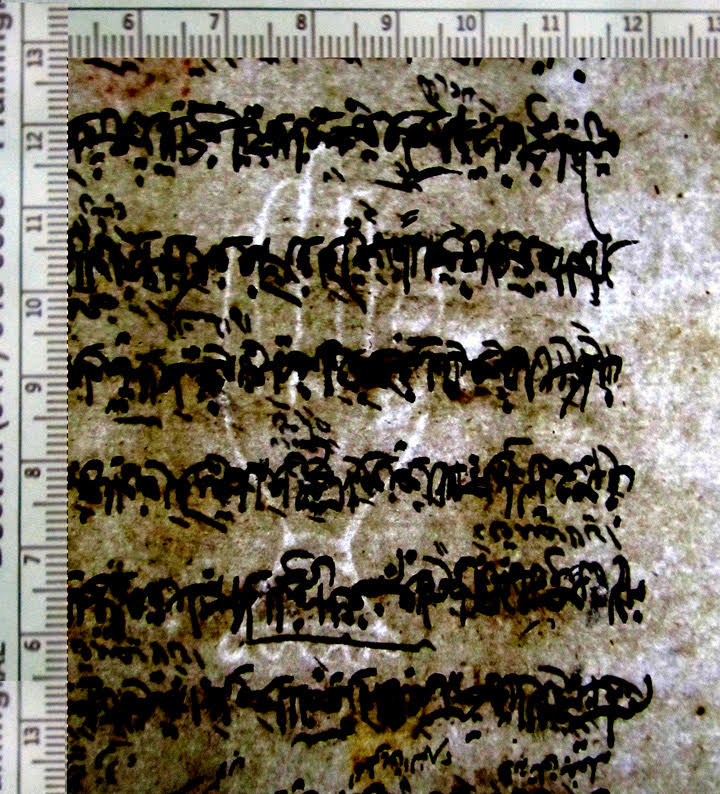
Private Collection, Treatise on Islamic Law, Newer Section with Glove Watermark.
Comparanda
Of specimens in Briquet, number 11133 is the closest, but not very close, and it is too late at “1479”.
Main | aux quatre doigts serrés, le pouce seul écarté
For the other Watermarks in this manuscript, see also
- Specimen IV.1.2.2. Scissors and Curled Letter or Mark (G?)
- Specimen V.3.3.1. Crescent . . .
*****
Specimen VII.1.1.1. Upraised Hand-in-Glove Surmounted by 6-Pointed Sun, Star, or Flower
Identifier: Private Collection, Land-Sale Contract in Spanish from Haro (near Santander) in Castile, Spain, dated December 1494.
Type of Artefact: Bifolium, with 2-page text on first leaf (pages 1–2) and leaf (pages 3–4) mostly blank, with docketing and upright watermark.
Type of Text: Land-Sale Contract
Place: Haro, Castile, Spain
Dated: December 1494
Language: Spanish
Script Sample
Opening of document, beginning with the standard “Se pan quantos esta carta de venta vieren . . . ” and naming the seller as a certain Ali Remiro (?), son of Ali Remiro, moro (?)
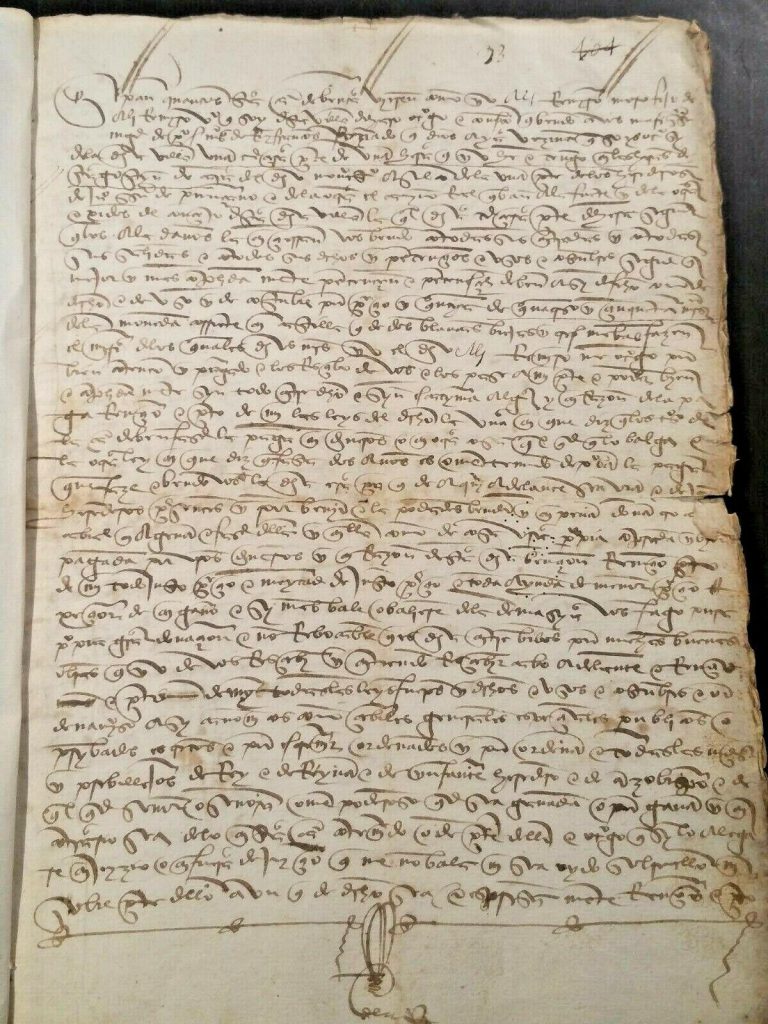
Private Collection, Sale Contract of December 1497 from Haro in Castile.

Private Collection, Sale Contract of December 1497 from Haro, Detail.
Watermark
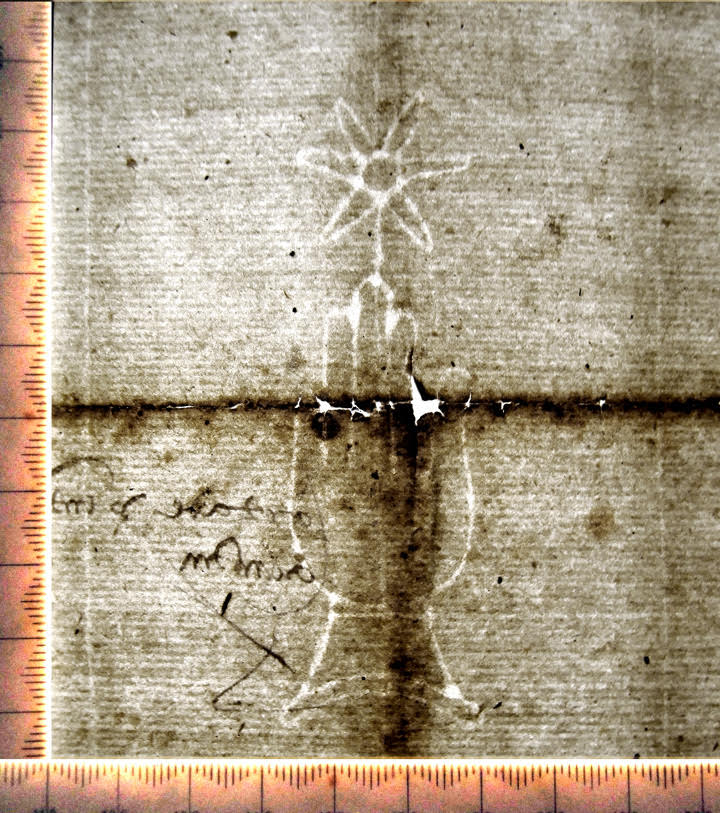
Private Collection. Watermark on Sale Contract on paper from Haro in Castile, dated December 1494.
Relatives
Closest in Briquet: 11154 (“Palermo 1482”, Southern Italy, 1479–82). See Vol. 3, p. 567 = Briquet text
(Main | aux quatre doigts serrées, le ponce seul écarté | manchette somméee d’une fleur ou d’une etoile)
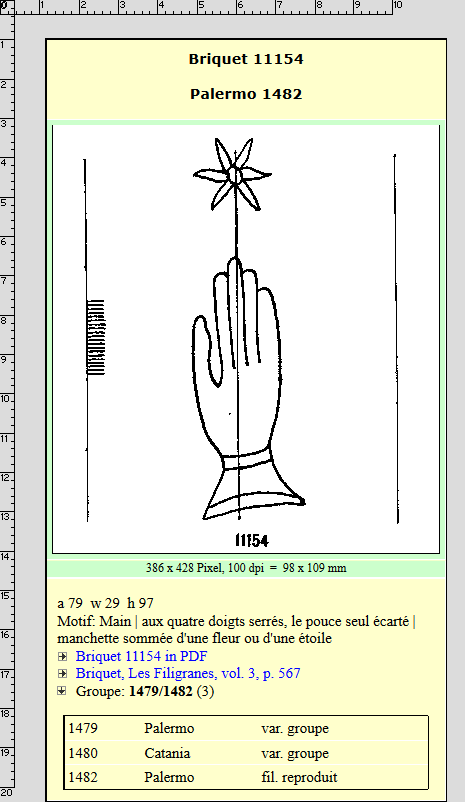
Briquet 11154 Glove with Star or Flower, via Briquet Online.
Closest in Piccard: Glove with “Blume/Blatt/Stern” (5-pointed), 2 specimens of 1472.
Figuren, anthropomorphe – Hand/Handschuh – mit Beizeichen – Blume/Blatt/Stern – fünfblättrig – ohne weiteres Beizeichen – Blätter – Strahlen spitz – mit Kreis in Blüte/Strahlen – mit Stange – Manschette zweiteilig
-
-
- Ref DE8310-Mc70_115 = Deutschland, Tübingen, Universitätsbibliothek, Tübingen, Mc 70 Bl. 115 (1472)
- DE8310-Mc70_108 = Deutschland, Tübingen, Universitätsbibliothek, Tübingen, Mc 70 Bl. 108 (1472)
-
Both examples occur in Part II, a collection of correspondence, in this “Humanistische Sammelhandschrift” (Mc 70) in Latin (catalogue description here, at p. 199).
*****
Specimen VII.1.1.2. Upraised Hand-in-Glove Surmounted by Crown
Private Collection, Document in French, dated 1477, naming as principal Guichart, “called Noysin”, lord of the fees called Noysin du Boys (most likely in Normandy), with a note in a different hand dated 29 November 1524, so perhaps the item is a copy of the 1520s.
Purchased in Cambridge, UK.
Script Sample
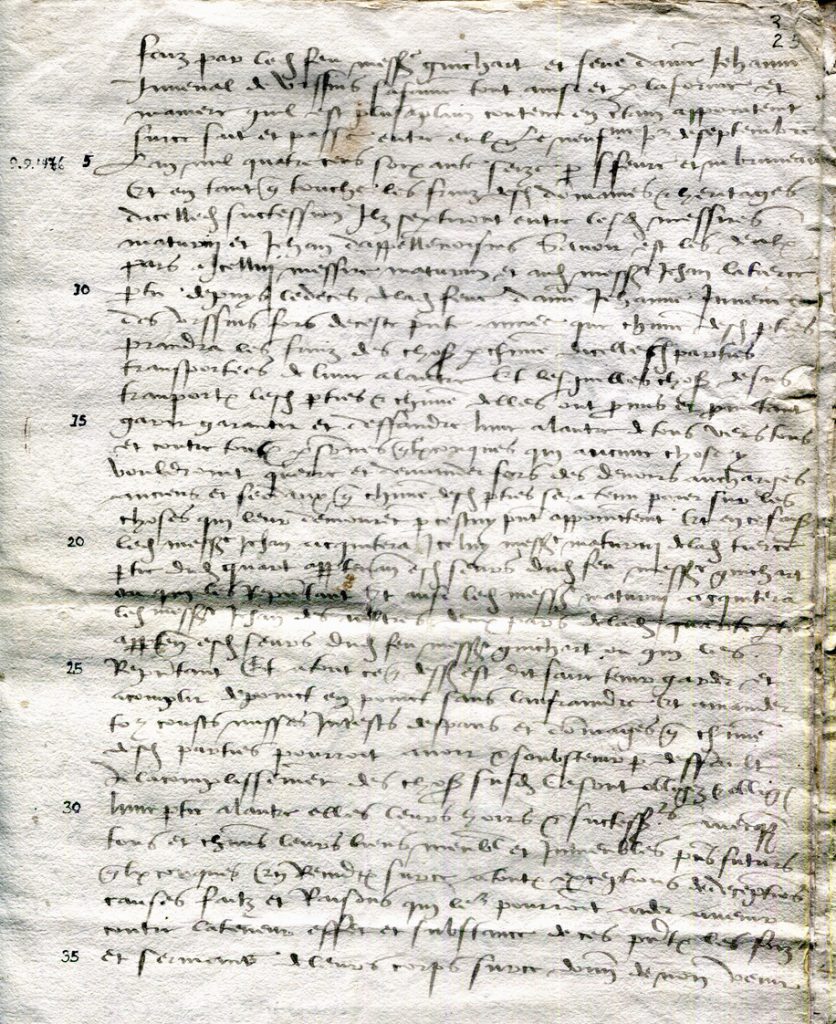
Private Collection, Paper Document of Noysin.
Watermark
Upright Hand-In-Glove with long and straight, closely spaced digits, a frilly cuff. The longest, middle finger, supports the level base of a festoon or crown with a comparably frilly top.
